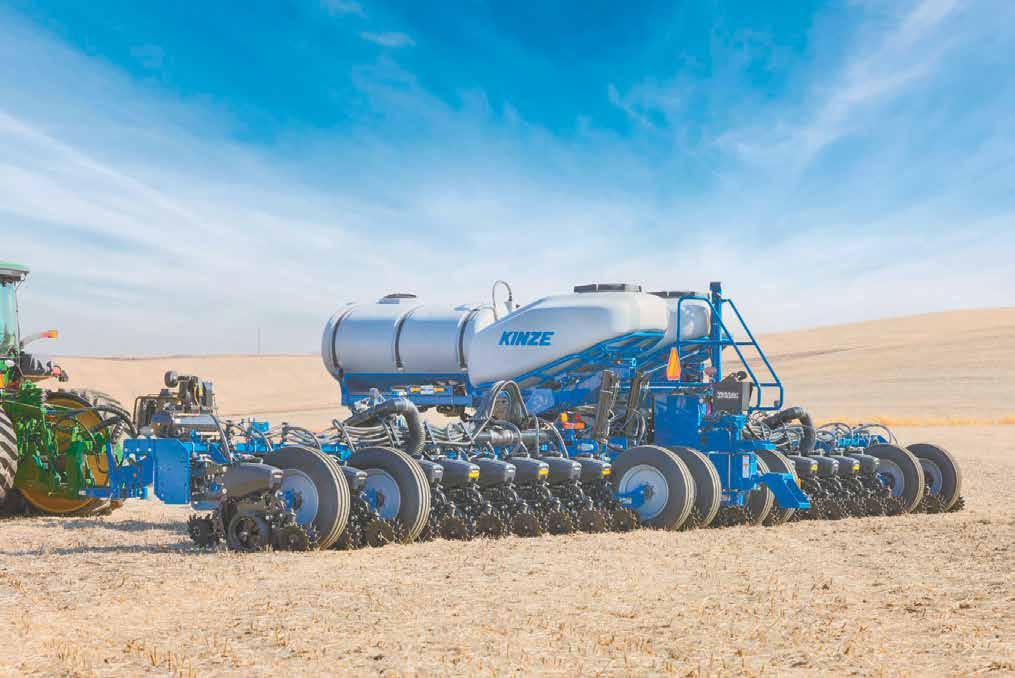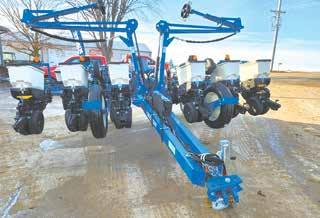






Heinzel selected as 77th Alice in Dairyland
By Stacey Smart stacey.s@dairystar.com
OCONOMOWOC, Wis. — The newest Alice in Dairyland started college with the ambition of becoming a veterinarian, but an encounter with the reigning Alice at the Wisconsin State Fair a couple of years ago sent her on a different career path.

“I loved the way Alice could connect with consumers of all ages,” Halei Heinzel said.
On May 4, Heinzel was selected as Wisconsin’s 77th Alice in Dairyland at Stone Harbor Resort and Conference Center in Sturgeon Bay. She was one of six top candidates that also included Cierra Essock, Katrina Hoesly, Michaela King, Kiley Pagel and Lauren Siemers.
Alice in Dairyland is a one-year, full-time communications professional with the Wisconsin Department of Agriculture, Trade and Consumer Protection. Heinzel will begin her term as Alice in Dairyland July 8.
“I am excited and honored to represent our state’s agriculture industry as Alice in Dairyland, and I’m looking forward to serving our state’s dairy farmers,” Heinzel said. “Sharing the message of the dairy industry is so important.”
Heinzel is the daughter of Sean and Kiersten Heinzel of Oconomowoc. Heinzel did not grow up on a farm, but she developed an unquenchable love for dairy while working her way into the industry.
Brokers prepare to host Barron County Dairy Breakfast
By Danielle Nauman danielle.n@dairystar.com
RICE LAKE, Wis. — For the second time in their farm’s history, the Broker family will be welcoming their friends and neighbors for the Barron County Dairy Breakfast June 1. The Broker family — Fred and Kathy, their son, Mike, and his wife, Cindy, and their children, Daniel and Garrett — milks 180 cows
their farm
Page 8




Strnad assists laboring heifer on Gagnows’ farm
By Stacey Smart stacey.s@dairystar.com
SEYMOUR, Wis. — Jon Strnad went above and beyond his duties as a driver for the United Parcel Service when he delivered a calf in between delivering packages April 15.
When driving past KJ Farms near Seymour around 2 p.m., Strnad noticed a heifer on pasture giving birth that seemed to be struggling. The calf was halfway out with the sack over its head, and neither the calf nor the heifer were moving much.
www.dairystar.com
ISSN Print: 2834-619X • Online: 2834-6203 522 Sinclair Lewis Ave. Sauk Centre, MN 56378
Phone: 320-352-6303 Fax: 320-352-5647
Published by Star Publications LLC
General Manager/Editor
Mark Klaphake - mark.k@dairystar.com
320-352-6303 (ofce) 320-248-3196 (cell) 320-352-0062 (home) Ad Composition - 320-352-6303
Nancy Powell • nancy.p@dairystar.com
Karen Knoblach • karen.k@star-pub.com
Annika Gunderson • annika@star-pub.com
Editorial Staff
Maria Bichler - Assistant Editor maria.b@dairystar.com
Stacey Smart - Assistant Editor 262-442-6666 • stacey.s@dairystar.com
Danielle Nauman - Staff Writer 608-487-1101 • danielle.n@dairystar.com
Abby Wiedmeyer - Staff Writer 608-487-4812 • abby.w@dairystar.com
Tiffany Klaphake - Staff Writer 320-352-6303 • tiffany.k@dairystar.com
Jan Lefebvre - Staff Writer jan.l@star-pub.com
Amy Kyllo - Staff Writer amy.k@star-pub.com
Emily Breth - Staff Writer emily.b@star-pub.com
Consultant
Jerry Jennissen 320-346-2292 Con nued from STRNAD | Page 1
Advertising Sales Main Ofce: 320-352-6303 Fax: 320-352-5647
Deadline is 5 p.m. of the Friday the week before publication
Sales Manager - Joyce Frericks 320-352-6303 • joyce@saukherald.com
National Sales Manager - Laura Seljan (National Advertising, SE MN) 507-250-2217 • fax: 507-634-4413 laura.s@dairystar.com
Assistant Sales Manager - Kati Schafer (Northeast WI and Upper MI) 920-979-5284 • kati.s@dairystar.com
Jerry Nelson (SW MN, NW Iowa, South Dakota) 605-690-6260 • jerry.n@dairystar.com
Mike Schafer (Central, South Central MN) 320-894-7825 • mike.s@dairystar.com
Megan Stuessel (Western Wisconsin) 608-387-1202 • megan.s@dairystar.com
Julia Merten (Southeast MN and Northeast IA) 507-438-7739 • julia.m@star-pub.com
Bob Leukam (Northern MN, East Central MN) 320-260-1248 (cell) bob.l@star-pub.com
Mark Klaphake (Western MN) 320-352-6303 (ofce) • 320-248-3196 (cell)
Deadlines
The deadline for news and advertising in the Dairy Star is 5 p.m. Friday the week before publication.
Subscriptions
One year subscription $42.00, outside the U.S. $200.00. Send check along with mailing address to Dairy Star, 522 Sinclair Lewis Ave., Sauk Centre, MN 56378. Advertising Our ad takers have no authority to bind this newspaper and only publication of an advertisement shall constitute nal acceptance of the advertiser's order.
Letters Letters and articles of opinion are welcomed. Letters must be signed and include address and phone number. We reserve the right to edit lengthy letters. The
and opinions expressed by
columnists and
are not necessarily those of the
Having grown up on a dairy farm, Strnad had seen that scenario many times. He slowed down and watched.
“When you see them laying like that, you wonder how long they’ve been in that position,” he said. “It doesn’t end well for the calf if things stay that way for too long. It looked like she needed help.”
Strnad was qualied for the job, so he parked his truck on the side of the road and hopped the fence.
“I’ve pulled calves ever since I was knee high to a grasshopper,” said Strnad, whose family continues to farm near Rio Creek. “Growing up, I remember pulling calves with my brothers and my dad.”
Strnad approached the pair slowly, but when the heifer stood up, Strnad knew he had to act fast.
“Now is when the calf could really get hurt,” he said. “I broke a hole in the sack close to the mouth so the calf could get air. Its head moved, and I thought she took a gasp of air.”
At this point, the heifer turned away from Strnad.
“I could tell she was groggy and wasn’t going to move much more,” he said. “I grabbed the front legs and pulled the calf out while trying to break the fall. When the calf landed on the ground, it still wasn’t moving. I cleared the pathway to get the slimy stuff out of her mouth and rubbed her nose. She

moved a bit. Then, she really started to move.”
The movement piqued the interest of the heifer, who came over and began licking the calf as Strnad observed from 6 feet away. All looked well to the man












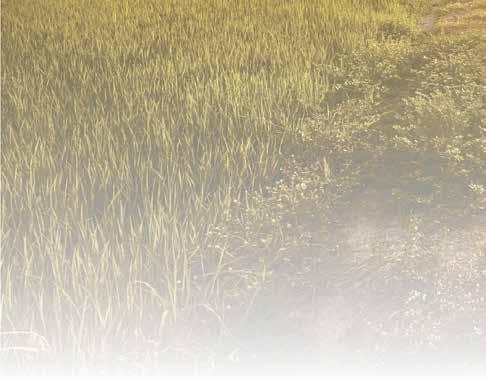



















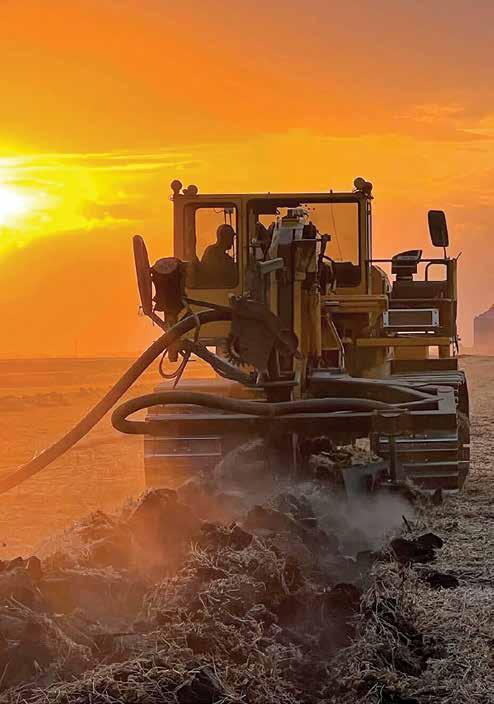








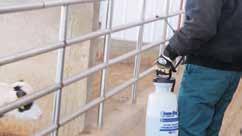
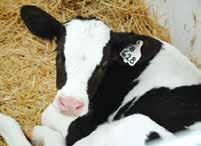


This pasture at KJ Farms is where UPS driver Jon Strnad pulled a calf from a heifer struggling to give birth near Seymour, Wisconsin. Strnad, who grew up on a dairy farm, was awarded a medal by the CEO of UPS for going above and beyond
“I saw the bull and knew that was my cue to leave,” Strnad said.
Having made the ultimate delivery, Strnad drove to the Gagnows’ house and knocked on the patio door. When Tracy Gagnow answered, Strnad said, “I’m just letting you know I pulled a calf.” Then, he turned and left.
“I was shocked,” Tracy said. “People call us sometimes when they see an animal is calving, but we’ve never had anyone deliver a calf before. His hands were bloody, and I thought, ‘That was rude of me. I didn’t even have him come in and wash his hands.’”
Kurt Gagnow, who farms with his son, Jacob, was working in the shop at the time and saw the UPS truck leaving the driveway but did not think anything of it. The Gagnows milk 50 cows and farm 350 acres on the farm Kurt worked on since he was 12 years old and purchased in 2001. Kurt’s 90-yearold father helps work the land.
When Tracy called Kurt to tell him the UPS man delivered a calf, he said, “What kind of box did it come in?” Kurt then proceeded to check on the newest member of the herd.
“Jon saved the calf’s life and the mom’s life,” Kurt said. “When they stand up like that, they can pinch a nerve in their back when the calf comes out, and it paralyzes their back end.”
Strnad has driven for UPS for 30 years and said this was the most unique situation he has ever been in. When the
CEO of the company heard about his heroic act, she sent Strnad a letter and gave him a medal.
“The medal is reserved for drivers who go above and beyond their regular duties,” Strnad said. “The CEO told me this made her day.”
Strnad believes in putting the customer rst, and looking out for the creatures on his route is part of that mindset. When he saw an animal in need, he acted.
“Mom and baby are doing great,” Tracy said. “She is a rst-calf heifer, and they can be touchy. If they don’t recover well, you could lose them, so it always makes you nervous.”
The Gagnows named the calf Joni, adding the letter “I” to the name of the man who helped save her life. The Gagnows did not know Strnad before that day and are grateful for the generosity and quick thinking shown by a stranger. Brought together by unusual circumstances on their small family farm, the Gagnows forged a friendship with their delivery man.
“We’ll always be connected now,” said Strnad, who has a special place in his heart for the calf he helped bring into the world.
Joni will be in the petting zoo at the Outagamie County Fair June 26-30 for anyone who wants to meet the spunky calf that might not have made it if a certain UPS man had not taken the time to stop that day.

• Silo Relining
• Barn Walls and Basement Resurfacing
• Bunker Silo Wall and Deteriorating Barn Walls Restoration
Approximately 1” of steel reinforced material added to bunker walls
6 gage heavy duty wire mesh installed
SERVING IA, MN, WI, IL AND SD CONTACT: 800-866-7327 • 563-586-2425 AND CELL 563-419-4279




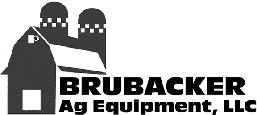


TUESDAY, JUNE 18th
















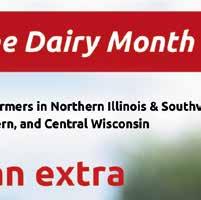





Heinzel loves animals and knew from a young age that she wanted to be a zookeeper, a farmer or a veterinarian. Her love for horses led her to join FFA as a junior in high school. It was through FFA that she met her rst dairy farmer and milked a cow for the rst time in 2018.
“That is when I fell in love with the dairy industry,” Heinzel said. “I love cows. They’re great animals, and I love the people who work with cows. Dairy farmers are some of the most passionate people on the planet.”
Throughout her time in the agricultural industry, Heinzel said dairy farmers have been a helping hand, ensuring she got the opportunities she needed to keep moving forward in the industry.
“I’m lucky to have met so many people through the dairy world and agriculture in general who wanted me to succeed,” Heinzel said. “I could give you a list a mile long of all the people who have helped me be the person I am today, and I am so grateful for all of them.”
Heinzel studied dairy science at the University of Wisconsin-River Falls for 1.5 years. When the coronavirus pandemic began, Heinzel was sent home. The time away from school forced her to reevaluate her priorities.
“I was able to start milking cows more consistently, and I wasn’t sure if I wanted to go back to college,” Heinzel said. “I wasn’t ready to give up on school, but I didn’t know what my next steps were.”
That was when she decided to enroll in the Farm and Industry Short Course at the University of WisconsinMadison.
“That was phenomenal for my education,” Heinzel said. “I loved seeing all the research happening rsthand and getting to work with the cows. One of my favorite things was having a lecture on the top oor of the dairy cattle building and then going downstairs to work cowside in the lab. It was great.”
Heinzel graduated from the short course in 2022 with certicates in agribusiness management and dairy farm management. She then reapplied to UW-Madison to pursue a bachelor’s degree with the belief that she was going to be a veterinarian. But that summer, while working at the state fair, she met a young lady whose job fascinated Heinzel. Meeting Alice in Dairyland for the rst time was life-changing for this city girl.
“I was doing a milking demonstration and Taylor Schaefer, the 75th Alice in Dairyland, was out front talking with consumers and sharing information about the state’s $45.6 billion dairy industry,” Heinzel said. “Later that week, I got to milk cows on the news with Taylor. It was an incredibly impactful experience for me.”
That winter, Heinzel changed her major to life science communications.
“Everything I’ve done for the past two years has been with the thought of running for Alice,” Heinzel said.
Heinzel has held internships with the Farm and Industry Short Course and Professional Dairy Producers and worked with the Wisconsin State Fair Dairy Promotion Board.
She graduated from UW-Madison in May.
“As someone who didn’t grow up on a farm, I needed somebody like Alice when I was little,” Heinzel said. “It does feel like there can be a lot of obstacles to getting into the dairy industry when you don’t grow up in it.”
Heinzel is passionate about getting youth involved in 4-H and FFA.
“That’s an important experience,” she said. “Finding that connection to agriculture and to the land in our local communities is why I wanted to be Alice.”
Traveling the state to learn more not only about the dairy industry but the diversity in agriculture and sharing that with consumers is what Heinzel is most looking forward to in her role as Alice.
“Wisconsin has a booming snap bean industry, maple syrup and countless other specialty crops ranking top 10 in the nation that most people don’t even realize we grow here,” Heinzel said.
She also looks forward to promoting opportunities in the dairy industry.
“The opportunities in this industry are endless,” Heinzel said. “From farmers and vets to nutritionists and geneticists, we need all kinds. Having farm kids come back to the farm or industry is great, but also having people from the city and urban areas getting involved in our industry is so important.”
Heinzel is lled with excitement as she prepares to take over as the next Alice in Dairyland.
“Alice reaches people across the state, beyond state borders and even internationally, and I want to be a part of that connection for people,” Heinzel said. “I want to inspire others.”

















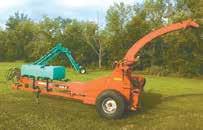





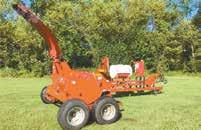





















Protect your cows and your profits by using:
Permethrin 10% • Permethrin 1% Synergized Pour-On Fly-Ban Synergized Pour-On


CONTACT YOUR LOCAL DEALER:
River Divide IBA Epworth, IA 563-543-7710
IBA Fahrney, Inc. Monroe, WI 608-325-4248
Dairyland Equipment Menahga, MN 218-564-4958
Zumbro Ag Solutions Zumbrota, MN 651-380-2856
Pettit IBA Farm Supply Lewiston, MN 507-269-5714
Valley Dairy Supply Corona, SD 605-432-5224
Central Valley Dairy Brandon, SD 605-467-0812
Manitowoc IBA Whitelaw, WI 920-732-4680
LakeView IBA Malone, WI 920-378-2924
Innovative IBA Oconomowoc, WI 608-347-4948
Balzer IBA Owatonna, MN 507-456-1617
Bill’sIBA, Inc Spring Valley, WI 715-505-2607
Little L Farm Supply Hawkins, WI 715-609-9474
Cows enjoy a total mixed ra on May 10 that is pushed up regularly with a robo c feed pusher at Broker Farms near Rice Lake, Wisconsin. The Brokers added the robo c feed pusher and robo c barn cleaners two years ago, which saves about 2.5 hours of labor each day.
They crop 375 acres of owned and rented land to raise feed and forage for their herd.
The decision to host was made by Daniel, the Brokers said.
“He heard they didn’t have a host and said we should do it because this was Grandpa’s 50th year farming,” Cindy said. “We hosted it in 2010, when Daniel was 2. Now, he’s 16, and Garrett is 12. With three generations here and all of the changes we’ve made, it seemed like a good time to host again.”
Hosting events like the dairy breakfast aligns with the family’s belief that sharing the story of their farm and the dairy industry is an important part of being a dairy farmer.
“It’s important for people to see where their food comes from,” Kathy said. “A lot of people don’t realize what goes into the food they buy in the grocery store.”
Mike and Cindy said they have witnessed through their sons how disconnected from the farm people are, even in rural northwest Wisconsin. Mike said their kids were the only ones in their respective grades who lived on a dairy farm.
“We have to be advocates for the dairy industry,” Cindy said. “We watch our kids growing up and realize their friends have no clue about farming. Even in second grade, Daniel loved farming and that is what he talked about, and the other kids didn’t understand what he was talking about.”
To share their story, the Brokers open their farm to visitors for tours and have worked with the local Boys and Girls Club to host a farm-to-table dinner.
This year is special to the Broker family as it marks 50 years of Fred’s dairying career. Throughout those years, he and his family have witnessed many changes, not only to their own farm but to the industry in general.
“I grew up on a dairy farm, but my parents sold the farm and bought a restaurant when I was 13,” Fred said. “I decided I’d rather work on a dairy
farm than in the restaurant.”
Throughout his teenage years, Fred worked on dairy farms, solidifying his decision that dairy farming was his calling in life.
“In 1974, I walked into the nancial institution with $10 in my pocket and said I wanted to dairy farm,” Fred said. “Sixty days later, I was milking 30 cows in a rented farm near Barron.”
Kathy gladly joined Fred on his dairy farming journey.
“I had always wanted to marry a farmer,” Kathy said.
The Brokers spent three years on the rented farm. During that time, Fred worked with one of his former employers to grow crops using the older farmer’s equipment.
In 1977, the Brokers purchased their current farm. Fred and Kathy began milking about 60 cows in a double-4 parlor. They maintained that herd size until 2002 when Mike decided to return to the farm after graduating from the University of Wisconsin-River Falls, where he met Cindy.
“I sent Mike to college hoping he’d change his mind about dairy farming,” Kathy said. “He came back more certain than ever that he wanted to farm.”
Cindy did not grow up on a farm but was immersed in agriculture through her father’s work as an agricultural teacher in Stevens Point. Her rst entry into dairying came while working part time feeding calves at a farm near UWRF, and she said dairy farming is a way of life she has come to love.
The rst of the changes to the farm included expanding the parlor to a double-6 and building a freestall barn to grow the herd to 130 cows. A year later, the rst half of a heifer barn was built.
At that same time, the Brokers capitalized on their neighbor’s specialty, calf raising, and began sending their newborns to Busse’s Barron Acres.
“Raising calves takes a lot of time and labor,” Mike said. “We have Busse’s so close; we can see their farm from ours. We decided that was the best avenue, and we were able to turn our calf barn into a holding pen for the parlor.”
Calves return to the Broker farm at 5 months of age.
“Since 2002, we haven’t stopped working to improve,” Cindy said. “We just keep trying to do better for our farm, for our animals.”
In 2017, the Brokers expanded the freestall barn to create an area for transition cows and built the other half of the heifer shed. They also built their current swing-12 parlor to accommodate the growth of the milking herd.
Mike and Fred agreed that their current size is the best t for them. Fred said they are at their maximum for cows, heifers and land. They employ one full-time person.
“This is pretty much our sweet spot; everything matches up,” Mike said. “We have enough land for all our feed. Our manure covers our land so we’re not buying tons of fertilizer.”
Hosting the upcoming

Broker Farms has witnessed growth
near
Wisconsin. In
breakfast has caused Fred to think over the changes and challenges of the past, and he has found one constant: his family’s dedication to their work.
“There is so much negativity about the dairy industry,” Fred said. “I want to show people: Here we are.

Here are our cows. They are healthy and happy, and this is how we care for them every day. I want people to know
what goes on, the amount of work and level of commitment we have to our cows and our farm.”






Rabobank senior dairy analyst Lucas Fuess said the cheese market has been squeezed, supporting Class III milk prices. “What I think has happened lately is a combination of weaker cheddar production coupled with very rm cheese exports,” Fuess said. “February and March cheese exports were exceptionally strong and that absorbed a lot more product than we might have expected.”
Thompson unveils farm bill language House Committee on Agriculture Chairman Glenn “GT” Thompson has released his farm bill text. It includes many provisions farm groups wanted, including premium support to help farmers buy up higher levels of crop insurance. It raises reference prices and doubles the Market Access Program and Foreign Market Development Program funding. Thompson’s bill also addresses the problems associated with California’s Prop 12, making it illegal for a state to impose standards on livestock and dairy production outside of its borders.
Dairy title details Thompson’s farm bill proposal makes adjustments in dairy programs. It increases the cap on Tier 1 coverage for Dairy Margin Coverage to 6 million pounds. There is an opportunity to update production history for DMC, and it provides a 25% discount on DMC premiums for dairy operations that enroll coverage for the life of the 2024 farm bill. The farm bill text mandates biennial cost surveys to make sure make allowances accurately reect the cost of manufacturing dairy products. Thompson’s dairy title would also restore the higher of formula for the calculation of the price for Class I uid milk until the Federal Milk Marketing Order updates are ratied.
Farm bill text delivers momentum for the process
The Russell Group President Randy Russell has been pouring through the lengthy farm bill text. “Chairman Thompson releasing this text is a very positive move,” Russell said. “It builds some momentum in a farm bill process
that has been long and prolonged. We can haggle about the details, but you’ve got to step in the batter’s box and start the game before you can score any runs, so I think this is positive.”
Ag Insiderborder. Farmers must be willing to voluntarily test asymptomatic cattle as well. Federal relief on the way for dairy farmers
‘The hardest one ever’
Senate Committee on Agriculture, Nutrition and Forestry Chair Debbie Stabenow has been in Congress for 27 years. She has worked on six farm bills and has been the leader for three of them. “This is the hardest one ever,” said the Michigan lawmaker.
 By Don Wick Columnist
By Don Wick Columnist
“They’re always difcult, but at this stage, we’re usually beyond the politics of nutrition and food and we’re actually negotiating the farm bill. That hasn’t happened yet.” Stabenow sounded optimistic about passing the farm bill while addressing the Rural Communities in Action event at the White House.
Activist groups step up federal focus
A new coalition of 15 animal rights groups has been formed to make local, state and national policy changes. The Animal Policy Alliance’s mission is to end what it sees as animal cruelty in large-scale farms. This coalition says it has had success with state initiatives and wants to increase animal welfare regulations at the federal level.
New H5N1 cases conrmed
The U.S. Department of Agriculture’s Animal and Plant Health Inspection Service has reported three more cases of H5N1 in dairy herds. Two of these outbreaks are in Michigan and one is in Idaho. There are now 49 total cases in nine states.
Canada cattle import restrictions
The Canadian Food Inspection Agency has created more requirements when importing dairy cattle from the U.S. This is in response to the rst conrmed case of H5N1 in a dairy herd in late March. Since April 29, breeding cattle have been required to have milk tested and a negative test to cross the
There’s nancial support coming for dairy farmers dealing with H5N1 in their cattle. That includes reimbursements for veterinarian costs associated with the virus. “We’re going to provide funding for heat treatment to dispose of milk in a bio-secure fashion,” said U.S. Secretary of Agriculture Tom Vilsack. “This is going to provide producers a safe option for disposing of milk.” Vilsack also announced increases in federal surveillance and testing of human and animal health.
Dairy consensus
The U. S. and Mexico have renewed their commitment to work together on mutually benecial dairy policies. This agreement calls for improving trade relations between the two countries, promoting dairy consumption and defending common food names. The National Milk Producers Federation and U.S. Dairy Export Council led the U.S. delegation.
Promoting Wisconsin agriculture products in Chile
Secretary of Wisconsin Department of Agriculture, Trade and Consumer Protection Randy Romanski led a trade mission to Chile to promote Wisconsin agriculture products. “It’s incumbent upon our agency to develop those relationships with Wisconsin businesses with Wisconsin farmers, processors and help them nd their market in the world,” Romanski said. The trade delegation included a representative of Dairy Farmers of Wisconsin and two cheesemakers.
Farm Credit collaboration
The collaboration agreement between AgCountry Farm Credit Services, Farm Credit Services of America and Frontier Farm Credit has been in place for a month. This is the largest collabo-
ration of its kind in the Farm Credit System. Marc Knisley, who is the executive vice president of AgCountry business development, said this collaboration protects the local brand presence. “It is an opportunity to keep these local associations more local, let them leverage the scale of working together and maybe slow down the merger trend that we’ve seen,” he said. In an interview with the Red River Farm Network, Knisley said this was a board-driven decision. The three entities will share leadership, planning and technology while local boards, ofces and programs will be maintained. “It’s not really a take-away, it is more of the added value that the broader leadership team can bring and the depth of knowledge and experience that we can bring in a collaboration,” Knisley said.
Hay stocks up over a year ago
As of May 1, hay stocks totaled 21 million tons nationwide. That’s up a massive 47% from one year ago. Meanwhile, Wisconsin hay stocks dropped 30%.
County fairs get a nancial boost
The Compeer Financial Fund for Rural America is providing support to 61 county fairs in the Upper Midwest to improve facilities. Grants totaling nearly $242,000 include everything from purchasing bleachers to adding ventilation and improving the sound system.
Trivia challenge
The Ford F-150 has been the bestselling pickup in the U.S. for nearly 50 years. That answers our last trivia question. For this week’s trivia, we look at June Dairy Month. This celebration began as National Milk Month. What was the year? We will have the answer in our next edition of Dairy Star.
Don Wick is owner/broadcaster for the Red River Farm Network of Grand Forks, North Dakota. Wick has been recognized as the National Farm Broadcaster of the Year and served as president of the National Association of Farm Broadcasting. Don and his wife, Kolleen, have two sons, Tony and Sam, and ve grandchildren, Aiden, Piper, Adrienne, Aurora and Sterling.















In the wake of the evolving animal health situation created by highly pathogenic avian inuenza in dairy cattle, the U.S. Department of Agriculture and the U.S. Department of Health and Human Services announced that signicant investments will be made to support affected dairy farms and reduce the impact and spread of the virus to mitigate risk and protect public health.
The USDA announced May 10 that $98 million in existing funds is being made available to its Animal and Plant Health Inspection Service to support these initiatives. USDA can make additional funds available with Congressional notication.
Dr. Michael Pruitt, the APHIS deputy national incident commander and director of district 4 veterinary services, appeared on a webinar hosted by the National Milk Producers Federation
May 16. The webinar discussed how affected dairy farmers can use these funds to work through and recover from the effects of the HPAI H5N1 virus.
“We are in what I would call uncharted waters,” Pruitt said. “The rollouts have been fast and furious. As we go along, there might be some changes that come about to make it more simple to take advantage of this. These nancial opportunities will potentially help you and will potentially help us as we try to get more knowledge of the disease prevalence in our herds in the United States.”
Pruitt dened an affected farm as any facility that has received a non-negative polymerase chain reaction sample from milk or via pathology from a necropsy situation.
As of May 17, the virus has been conrmed on 51 dairy farms in Colorado, Idaho, Kansas, Michigan, New Mexico, North Carolina, Ohio, South Dakota and Texas.
“The focus right now is on those affected herds,” Pruitt said. “I suspect we will pick up more herds as pre-movement testing continues. We’re asking producers that are affected by the disease get conrmation at either a National Animal Health Laboratory Network or National Veterinary Services Labo-
Turn to H5NI | Page 12
tests do you use and what do you like about those tests? We do normal milk sampling and use the pregnancy check. It’s less cow handling for the staff.
Which is your favorite and why? I like to know the fat and protein. To make better culling decisions.
How does testing with DHIA bene t your dairy operation? It is hard to make decisions without current information. So, testing gives us that.

Tell us about your farm. I farm with my wife, Kate, and parents, Betty and Joe, in Sauk Centre. We enjoy working with good cows and better people. From our employees, consultants and even a few sales people. The farm consists of registered Holsteins and crops to feed them. We strive to get a little better each year by improving both.











USED TRACTORS
CIH 9330, FWD, PTO, 3 pt., 2,800 hrs. .$125,000
CIH 8940, FWA, 1,800 hrs. ..................Coming In
CIH 8920, 2WD, 3,500 hrs ......................$84,000
CIH 8920, 2WD, 6,700 hrs. .....................$65,000
CIH 8920, 2WD, 7,900 hrs. .....................$59,000
CIH 8920, 2WD, 4,100 hrs ......................$72,000
CIH 8920, FWA, 2,600 hrs ....................$110,000
CIH MX240, 4,700 hrs .............................$85,000
CIH MX220, FWA, 3,600 hrs. ..................$88,000
CIH MX120, 2WD, 3,800 hrs. ..................$72,000
CIH MX120 w/loader ...............................$75,000
CI 7220 w/6500 hrs., 2W ......................Coming In
IH 1456, cab ............................................$22,000
IH 1086, 9,700 hrs. w/ldr. ........................$23,000
IH 1066, no cab .......................................$13,500
IH 1086, 5,000 hrs. ..................................$24,000
IH 686 ......................................................$14,000
TILLAGE
CIH Tigermate II, 26’ ...............................$28,000
CIH Tigermate II 26’ w/rolling basket.......$32,000
CIH Tigermate 200 w/basket, 34’ ............$42,500
CIH Tigermate 200, 28’ w/rolling basket..$40,000
CIH Tigermate 200 28’ w/basket .............$37,000
CIH RMX 340 28’ w/mulcher ...................$44,000
CIH 3800 16’ disc ......................................$9,500
CIH 527B .................................................$17,500
CIH 530C Ripper, nice.............................$38,000
ratories. We’re preparing to roll this out as quickly as we can.”
Affected farms are eligible to submit receipts for the program, commencing with the date of the USDA conrmation of the presence of the virus on their farms. They can request program funding for 120 days following that conrmation.
“We’re working right now on building the team that we’ll need to support this,” Pruitt said. “Our administrative services unit feels very comfortable that we have assets in place right now with the skill sets that are necessary to immediately employ this activity. We’re ready to go as soon as this thing reaches its ofcial roll-out.”
Pruitt said the Farm Service Agency will provide assistance for H5N1-related milk loss and is developing rules for that arm of the program.
Detailing the programs available, Pruitt stressed the importance of using personal protective equipment on affected farms.
“We’re looking to support you by trying to slow down any potential for accidental exposure on those dairies where the virus could potentially
move to humans,” Pruitt said. “Producers who elect this option can receive a at rate per employee up to $2,000 per month to provide PPE. In addition, if they have their own uniform services, we will help support increased laundering services. The idea is to provide PPE, whether disposable or reusable.”
The funding for increased PPE is limited to four months following the initial conrmation on each farm.
“In addition to that, people can take advantage of very specic information that might not have been on their radar before regarding biosecurity auditing, planning and implementation,” Pruitt said.
Producers can receive a one-time offer of $1,500 per affected premise to work with either private entities or state personnel to develop and implement enhanced biosecurity measures.
Producers will need to keep all receipts and invoices for the process to be reimbursed.
With increasing biosecurity measures, up to $100 will be paid to farms that wish to install an in-line sampler for their milk systems.
Up to $2,000 over four months will
Cattle, Sheep, and Goat Hoof Trimming
be available to affected dairy farmers to put toward the purchase of a pasteurization unit or other expenses related to heating and disposing of affected milk in a biosecure fashion.
“There has been some concern about just dumping the milk, but right now, the only safe option we’ve got is to dispose of milk after it’s been heated,” Pruitt said. “At this time, heat treating milk is the only conrmed method for biosecure disposal of affected milk.”
Pruitt said while some farms treat waste milk fed to calves using ultraviolet light rather than pasteurization, the effectiveness of UV light in terms of killing the H5N1 virus is not conrmed.
“We can reimburse producers that have experienced cattle that are going to the sick pen and have to be treated medically to get those animals through that sick period to get them through resolution,” Pruitt said. “We can support that up to $10,000 total per affected premise.”
The reimbursement can also be applied to veterinary fees for collecting samples for testing. The USDA will also cover the shipping costs of sending samples to a NAHNL lab for testing
for two shipments per month, not to exceed $50 per shipment for each affected premise.
A team through the Ruminant Heath Commodities Unit is working on building a related program that offers an opportunity to test bulk tank milk, probably weekly, Pruitt said. The number of samples would be based on the number of cows and the number of tanks.
“It will be a really good support mechanism for those people who want to go past being required to do premovement testing every time they have a load that needs to go,” Pruitt said. “This would offer us a chance over a period of three weeks to help establish herd status. That would give us a chance to take a look at herd prevalence and at the same time give you a chance to feel more comfortable that your cattle are not experiencing disease. We could help you establish and maintain that status.”
To enroll in the programs, affected dairy farmers must contact the USDA’s designated area veterinarian in charge of their state. That information can be found via the APHIS website.

We use a hydraulic upright chute for less stress.
“Our







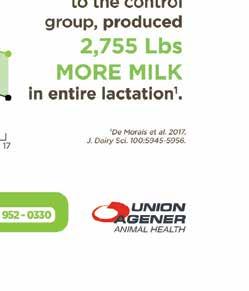
WASHINGTON — Within 25 years, exports of U.S. dairy products have increased nearly sevenfold. Today, almost 20% of U.S. dairy production is exported, which means that one in six tankers of milk leaving a dairy is going for exports.
“Exports impact every farmer,” said Krysta Harden, president and CEO of the U.S. Dairy Export Council. “Exporting gives protection to farmers to ensure there is a home for their milk, whether it’s around the corner or around the world. Exports are becoming a much more important factor in U.S. dairy, and for us to grow as an industry, we must have markets outside the U.S.”
USDEC was created 28 years ago by dairy farmers through the national dairy checkoff program. USDEC is an umbrella organization bringing together elements of the dairy chain to build and grow markets around the world.
“It’s a collective effort that adds value to farmers’ milk checks by adding new markets for commodities,” Harden said. “This is especially important if you have a new generation that wants to come back to the farm. USDEC wants to help the young farmer gure out how they t into a global market and the growth that provides.”
The U.S. is the third largest exporter of dairy products in the world, following New Zealand and Europe. Harden said the U.S.’s biggest market and closest ally for exports is Mexico.
“Mexico is a large consumer of dairy, and they love our cheeses,” she said. “Dairy is a big part of their diet, but it’s not a market we take for granted. We sit down with Mexican dairy farmers and processors regularly. If there’s more demand for dairy in Mexico, it helps Mexican dairy farmers and U.S. dairy farmers.”
Harden said Mexico imports about 30% of its dairy consumption even though the country has a successful dairy-producing industry.
“Our trade is not about displacing any farmers; we need more farmers in the world, not fewer,” she said. “We work hand in hand in many cases because Mexico still can’t meet the demand.”
Harden said USDEC sees potential in Central America and South America. The council is also focused on Southeast Asia and has a brick-and-mortar ofce in Singapore that includes a test kitchen, chef and meeting space.
“It is a big world, and we have to look at it market by market and situation by situation,” Harden said. “Southeast Asia is a very large market with a potential for dairy ingredients.”
With additional ofces in Mexico, South America, Korea, Japan, the Middle East, Taiwan, Hong Kong and China, USDEC has outposts around the world. There are 10 in all, including the main ofce in Washington, D.C., with more ofces to come. Among the prospects is Sub-Saharan Africa.
“We’re making sure U.S. dairy is front and center in emerging markets, growth markets and established markets,” Harden said. “We have to be aggressive and strategic and make sure
we know and understand these markets. We work closely with our governments and governments in these key countries to ensure our products are allowed in. There are a lot of requirements to make that happen.”
The U.S. is rebounding from a tough year for exports last year following a record-breaking year in 2022, when U.S. dairy exports totaled $9.66 billion.
“We were a little lower last year, but we’ll climb back up this year,” Harden said. “Right now, about 17%-18% of production is going into exports. That helps the milk check. If we don’t have a place for those products, where are they going to go? Exports give a home to milk that would otherwise be in a surplus which causes oversupply and less money for farmers.”
With 96% of the world population falling outside U.S. borders, Harden said there is a responsibility to help feed a hungry world.
“There are opportunities to grow markets that may not have dairy in their diet to the extent they should,” Harden said. “Many countries are decient in the vitamins and minerals found in dairy and do not reach the suggested intake for dairy products. This is a great opportunity for us to give more of the world a healthier diet through the sustainable nutrition that comes from dairy.”
Harden also sees exports as a way to help people understand the many uses of dairy, from traditional foods to ingredients to proteins and permeates.
“There are all sorts of things we can do with dairy,” Harden said. “We export a lot of cheese, and there is growing demand for U.S. cheese around the world. But powder, proteins and other ingredients from dairy are critical.”
Milk processors play a role in exports, and USDEC is often the facilitator, matching up exporters with buyers. The organization works with governments around the world to ensure standards and qualications are met.
“We help facilitate the process for our member companies and cooperatives, making sure those who want to buy from the U.S. know who to buy from,” Harden said. “If you want to sell outside the U.S., we help make sure you understand what that’s going to look like.”
The high-quality and high-value reputation of U.S. dairy products makes it an attractive option for countries looking to import. Building relationships and partnerships with these countries is the important next step, Harden said.
“When I look at where this industry will be in 10 years, we will be exporting more, and we will be taking market share from our competitors,” Harden said. “There will be new markets that we’re not doing business in today that we’ll be doing business with in 10 years.”
Taking market share from competitors is something that Harden sees as inevitable.
“We have the resources to grow production here: land, water and a much more favorable regulatory environment than our competitors,” Harden said.
“Some states have stricter environmental regulations than others, but by and large, we are a business and ag-friendly country.”
USDEC is gearing up for World Milk Day June 1, which will kick off June Dairy Month.
“We’ll have celebrations with our counterparts and consumers in every one of our locations and in every language,” Harden said. “That day and all of June Dairy Month is a time to say thank you to our great dairy farmers.”
As exports grow, Harden sees it as key to helping sustain the dairy industry and drive growth.

“I want dairy farmers to look at exports and trade in a positive light,” Harden said. “It is an opportunity for us to grow as an industry and is a positive reason to stay in dairy or bring in the next generation.”














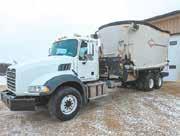




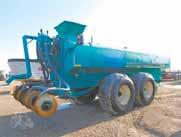

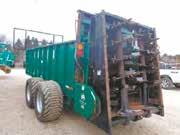













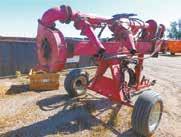


What is the most significant remodeling project you’ve done on the farm?
Hammerand Dubuque, Iowa Dubuque County 210 cows
What is the most signicant remodeling project you’ve done on the farm?

Upgrading to a milking parlor in the fall of 2021. We built a double-12, rapid exit parallel parlor. Previously, we were milking in a double-8 herringbone, and we were walking the cows 300 feet down a hill to the old stanchion barn.
Tell us about the planning process and what it took to complete the project. The biggest decision was to decide on a herringbone or a parallel parlor. I decided to go with a parallel parlor because it was safer; I was tired of getting kicked in the herringbone parlor. To plan for the project, I toured as many parlors as I could. Even if I got just one good idea out of a parlor tour, it served me well. To complete the project, we built the parlor and holding area onto the existing freestall barn. This involved concrete, plumbing, electrical and construction work. Most of the labor was completed with the help of a couple friends, my brother-in-law and father-in-law. My grandpa always told me that price is soon forgotten but quality is long remembered, so I kept that in mind when planning the size of the parlor stalls and how much room the cows had to exit.
What was the reason for making the change, and what kind of impact has this had? The biggest reason for the change was to eliminate the walk from the freestall barn to the old parlor. It wasn’t very fun chasing cows down to milk in a blizzard; they always seemed to run, and then, they would fall and get hurt or slip on the ice. The weather was a big factor in deciding to make the upgrade. It has saved time, being able to milk with 24 units instead of 16. The biggest impact is seeing less injuries and increased longevity in the older cows due to less walking every day.
What do you like and dislike about remodeling projects? I like when it’s complete and done. I dislike paying for it and the constant headaches every day while building. I also like feeling like you’re doing something to benet yourself and the cows today and in the long run. Once it’s done, you’re happy you did it.
What kind of project are you considering? I nished building a fresh cow barn and calving barn in January. It’s one building for fresh cows. It took about eight weeks to build. It was intended to be a bedding pack, but I designed it where I could switch to free stalls if I didn’t like the bedding pack. After only a month, I poured a wall and put free stalls in for the fresh cows. They stay for about 10-20 days, until the threat of ketosis has generally passed. It has made it easier to keep an eye on fresh cows.
Tell us about your farm and plans for the dairy farm this year. The farm is 175 acres, and I also rent an additional 80 acres from neighbors. I milk 210 cows with my wife, Jennifer, who also works full time as a nurse practitioner. We have a 10-month-old daughter, Laurna. I have ve part-time people who help milk. Our milk is shipped to Wapsie Valley Creamery in Independence, Iowa. The plan for the dairy this year is to hopefully pay off some things with the higher milk price. Then, we are actually going to start building a house this fall.

 Mark Lamborn Luana, Iowa Allamakee County 180 cows
Mark Lamborn Luana, Iowa Allamakee County 180 cows
What is the most significant remodeling project you’ve done on the farm? Putting the robots in two years ago.

Tell us about the planning process and what it took to complete the project. We looked at a lot of other robot/freestall barn setups before making our decision to retrot our 6-row freestall barn. We signed the paperwork ordering our three robots at the end of March 2021. Planning involved members of DeLaval, an electrician, plumbers, a cement contractor, the excavating crew and carpenters. We were delayed because of post-pandemic trucking problems. Our robot startup day was Jan. 18, 2022. We had help from family, friends and neighbors in bitter cold conditions to push the cows through.
What was the reason for making the change, and what kind of impact has this had? The hired man and my shoulders were about shot from milking all the time. We checked into hiring milkers and soon found out it would cost about what it would cost for a robot project payment. Robotic milkers are also working for you 24/7. They don’t call in sick or not show up. Having robots has allowed me to go to sporting events easier, and I have more time for maintaining and xing things.
What do you like and dislike about remodeling projects? I like looking at other people’s layouts and talking to them about things they would or wouldn’t do again. I dislike the cost of everything and am thankful interest rates were lower two years ago.
What kind of project are you considering? I would like to do a calf barn and am planning on one or two more robots.
Tell us about your farm and plans for the dairy farm this year. My wife and I are the sixth-generation dairy farmers on our heritage farm. Jill works part time in healthcare along with taking care of the farm bookwork. We have ve children. Brock is a real estate agent and insurance agent. He helps during planting and harvest. Blake works for an excavating/construction company. He also helps with eldwork when able. Avery is a junior in high school. She is active in sports and working off the farm. Jaxon is a freshman in high school. He plays sports and helps a neighbor milk cows in their parlor. Camden is our “farm manager.” He knows everything that is going on. We also have one full-time employee, who is also a hoof trimmer. We milk 180 cows, raise our heifers and nish our steers. We farm approximately 1,300 acres, doing all our own chopping and spraying. Our milk is shipped to Prairie Farms Dairy Inc. only 4 miles from our farm in Luana. We have no big projects planned for this year.
Travis Brantner Mondovi, Wisconsin Pepin County 85 cows
What is the most signicant remodeling project you’ve done on the farm? Turning our pole shed into a freestall barn. Before that, we had the cows in a 35-stall stanchion barn. We were milking about 60 cows at the time, and the extra cows were on a bedded pack in the winter with no roof.
Tell us about the planning process and what it took to complete the project. It was just an idea I had in my head. Before I bought the farm, I was an A.I. technician, so I had seen a lot of farms. We did this project in summer 2020. It took us ve months. We did all the work ourselves, so it was myself, my wife, my brotherin-law and mother-in-law, my uncle and my parents. It was a pole shed with a lean-to addition off it. Between the shed and lean-to, there was a tin wall that we removed. It had a dirt oor, and we had to haul 50 loads of dirt to build up the oor to become level. Then, we cemented everything. We have sand bedding now, so we cemented out curves and installed free stall loops. Penn State Extension was a good resource for measurements.
What was the reason for making the change, and what kind of impact has this had? Cow comfort was the main reason, because our switch cows were outside on a bedded pack year-round. When we put the free stall loops in, our somatic cell count improved, and the milk production went up. It allowed us to add about 25 cows at that point. It’s been great for us.
What do you like and dislike about remodeling projects? I like the mental aspect of it. I see it in my mind, and I can envision what I want it to look like when I’m done. I hate the dirt work and cement work. I could frame things all day. It’s just something that I think takes so long. I don’t care for the pouring of the cement either, because you have one shot at it.
What kind of project are you considering? I’d like to put up a freestall barn for the heifers. Right now, they’re in a dirt lot. I would like to put up a barn for them. I’d have three groups, because we start them on silage at 6 months old. Then, they go to the breeding pen for 11 months. Then, I’d have a pregnant pen.
Tell us about your farm and plans for the dairy farm this year. I’m the fourth generation on this farm. I bought the farm from my parents six years ago. We operate 340 acres of tillable owned and rented ground. We raise all our replacements. We ship milk to the Eau Galle Cheese factory. We milk in a swing-8 parlor that we bought used and put in two years ago. We want to maintain this year. We’ll make little improvements here and there.

Michelle Popp
Unity,Wisconsin Clark County 30 cows

What is the most signicant remodeling project you’ve done on the farm? Removing the barn cleaner chute, chain and the entire barn alley. Tell us about the planning process and what it took to complete the project. The planning process lasted a few days as we needed to make a quick decision. We hadn’t been using the barn cleaner during the summer because the cows were out to pasture or eating at the outside headlock area. In October 2022, when I ran the barn cleaner, a bunch of liquid was under the manure chute outside the barn. A thin line under the barn cleaner chain had rusted through. My husband and I disliked that outdoor manure chute in the winter when manure would freeze on or ice would freeze the chain to the manure chute. I contacted a friend who had poured concrete for us before, and between all of us, we came up with a plan. We ran all the chain out of the barn on a Friday afternoon and busted the gutters and middle alley out on Saturday. We had to be ready for cement trucks at 7 a.m. Monday. We had a limited pile of ll that we thought would be enough, and of course, we couldn’t get more on a Saturday afternoon when we realized we had a problem. Apparently, it is common for older barns to have a pond of water under the foundation. We buried our skid loader twice in the barn. My cousin had a skid loader with tracks on, and he came on Sunday and helped us nish taking out the rest of the alley and gutter. We hauled the at gutter pieces of concrete back into the barn as ll where we had made a hole. Some people get away with cementing in their gutters, but our gutters weren’t deep enough to make that work. We searched out people who had done the same project and found out that barn alleys weren’t poured in stall barns to handle the skid loader weight on a daily basis. That is why we wanted to pour new concrete all the way across the alley. We put rebar in the alley to hold up under our skid loader. The people involved were our family, two cousins and a re-
Zack Lacenski
Denmark, Wisconsin
Brown County 40 cows

What is the most signicant remodeling project you’ve done on the farm? Remodeling our heifer barn. It was built in 1941 for my grandpa’s milking herd. It had a oor-to-peak mow on one end, a drive-thru thresh oor in the center and stalls with a mow above on the other end. When Grandpa bought the farm we’re on now and moved the cows here, that barn became the heifer facility. In 1996, the barn was moved 2 miles to the home farm. A lean-to was added on one side for more width, with a full-length row of free stalls along each side wall and a new hay mow oor built above. We also added a gutter with a barn cleaner behind each row of free stalls. Eating aisles are slightly sloped to the fully grated gutters, and manure gets worked into the gutters by the cattle. The center feed alley is 6 feet wide, which is enough width for a round bale or a small skid loader.
Tell us about the planning process and what it took to complete the project. My dad was the general contractor. A neighbor has a similarly designed barn that a lot of ideas were taken from. The concrete foundation was poured and backlled, and the barn was moved into position and set on cribbing. Then, the concrete block wall was built, and the barn was set down on it. We built the haymow oor and completed the gutters and concrete work inside. Next, all pipe work for partitions and gates was


tired concrete guy. We also grooved the cement. At the time we did this project, the barn cleaner chain was $13 per foot. Our chain was worn out. We did our project for a fraction of what it could have cost us.
What was the reason for making the change, and what kind of impact has this had? We were forced to make a decision because winter was coming, and we had a chute leaking manure. We have never regretted the decision. The rst winter, I scraped behind the cows right after we fed them, and it worked. But, I had to watch out for fresh cows or heifers backing up in the stall so I wouldn’t hit them. This past winter, we totally changed things and used our barn as a freestall barn and feed the cows outside in headlocks. They are chased outside, and the barn is scraped. Then, we put down grain to get them back in. After they are tied, they get more grain and top-dress distillers. All forages are fed outside.
What do you like and dislike about remodeling projects? Remodeling projects can be exciting for something new or something different, but they can also cost a lot of money. You always hope you are making the right decision.
What kind of project are you considering? We have been downsizing, and we are getting below the minimum number of weaned calves through breeding-age heifers to hold our spot at a heifer raiser. We need to gure out how to deal with this group of animals we will have at home. One option we are looking at is more seasonal calving to have mostly one size of calves. We sold all of our February and March calves. Our seasonal calving would be approximately mid-May to mid-September.
Tell us about your farm and plans for the dairy farm this year. We own 98 acres, 40 of it being wooded, and rent 76 acres of hay ground. We rotationally graze when it works and make hay on the rest of the land. We ship our milk to Nasonville Dairy. My husband helps me when he’s not working his full-time job and does the sire selection and breeding. We get help from family members to pick up and haul baleage. Our plans for this year are to nd a budget friendly option for the group of calves we will be keeping at home, expand our markets where our Jersey Girls lotion is sold and enjoy the freedoms we have being our own boss. We have been putting priority on time together with family, which makes us better farmers.
nished. The project was started at the end of July, and the rst cattle were moved in on Christmas Eve 1996.
What was the reason for making the change, and what kind of impact has this had? We needed more room for heifers, and the project doubled the capacity of the barn while making it more labor efcient. Before, all manure had to be forked by hand into the gutter for the barn cleaner to take it out. Now, all we have to do is turn on the barn cleaner switch.
What do you like and dislike about remodeling projects? I like having a plan and seeing that plan come together every step of the way. I dislike the problems that arise when things don’t go according to plan.
What kind of project are you considering? I am in the process of building a shop and storage shed. When that is complete, part of the old machine shed will be remodeled for housing my steers that are at another farm that I rent. The poles are rotting off at ground level, so I plan on putting a concrete wall in place of the poles.
Tell us about your farm and plans for the dairy farm this year. My wife, Ashley, and I own the farm. We have three boys: Jacob, Adam and Abraham. We milk 40 cows in a tiestall barn, and our milk is shipped to Scray Cheese Co. We raise our heifers for replacements, and the bulls are raised as steers. We have 125 head total. We farm 275 acres of corn, alfalfa, soybeans, wheat and oats to feed our cattle. Any extra is sold as cash crops. My dad is here most days, helping with chores and eldwork, and my mom does tractor driving too. Other family and friends help as needed. My plan for this year is to remodel the old shed to use for steer housing after the new shop is up.



































MARATHON, Wis. — A robotic milking system has been on the radar at Draeger Dairy near Marathon for nearly a decade.
After years of contemplation, 12 Lely Astronaut A5 robotic milking units were red up Aug. 21, 2023, launching the Draeger family into a new era on their Marathon County farm.
Draeger Dairy, home to nearly 700 milking cows, is operated by brothers Jim Draeger and Alan Draeger, along with Jim’s children, Heidi and Aaron Gauerke, TJ Draeger, Teanna Draeger and Kylie Draeger.
Nearly 550 cows call the robotic barn home. The other 150 cows continue to live in the older freestall barn and are milked in a double-12 parlor. Eventually, the Draegers hope to ll both barns and milk the facility’s capacity of 900 cows.
Since moving into the facility, the herd is averaging 92 pounds of milk per cow per day, with an energy-corrected equiv-
alent of nearly 100 pounds.
The Draegers are inviting others interested in the technology to view theirs in an open house from 10 a.m. to 2 p.m. June 15.
“For the past 10 years, I have been saying that robots were going to be our future,”
Heidi said.
While Heidi was the early advocate and long convinced of the value robots could play in the farm’s future, the rest of her family came on board about four years ago. Like many farms, labor issues were the driver that ultimately brought robotic milking to the farm.
“We have a lot of local competition for labor,” Aaron said.
Jim agreed. He said the nancial implications of procuring staff convinced him.
“It’s a struggle to nd employees to milk the cows, especially knowing that employee wages and benets like health insurance and workers compensation continue to escalate,” Jim said. “You know that robot is not going to ask for a raise. It is not going to call in sick.”
When the decision was

made, the Draegers investigated the technology available and researched and toured facilities.
“The reputation of Seehafers and Lely were huge, knowing you have dealer support and knowledge,” TJ said. “Lely fo-
cuses on robots. They are on the forefront of robots, driving the innovation.”
As a team, the Draegers felt the free-ow model was the best t for their cows.
“We visited both free-ow and guided-ow barns, and by the end, we were all on the same page that the free-ow offered superior cow comfort,” Jim said.
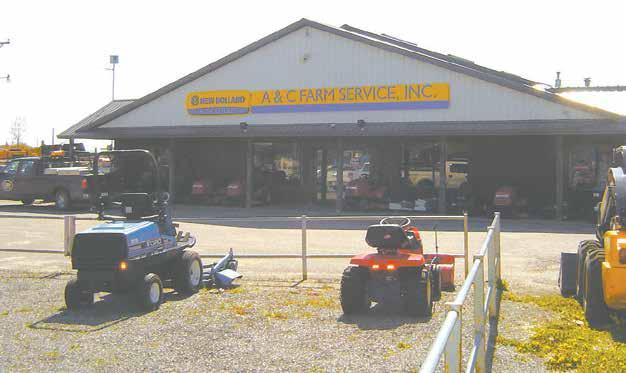










“We use Udder ComfortTM on fresh cows, works tremendously on fresh 2-yr-olds. It softens udders quickly, reducing pressure and increasing comfort for better performance. We have used Udder Comfort for 10 years, blue spray in the parlor, white lotion at shows. We see a bagging to milking out after,” says Jeff King, Kings-Ransom Farm, Schuylerville, New York, milking 1000 registered Holsteins, producing over 30,000M at 90,000 SCC.
Award-winning King Brothers Dairy milk and dairy products start with quality udders making quality milk.
They credit good staff, genetics, sand bedding, cow comfort, consistent milking routines, including Udder Comfort for fresh cows.
With over 120 EX in this large freestall herd, they produce A.I. sires like Dynasty, Cadillac and Dropbox from homebred cow families like Cleavage, Cleo, Dextra.


“It’s easy to love the great ones, but when you have cows walk in the freestall barn with good feet and legs and udders full of milk, cows the kids enjoy showing and do well with and learn from, that’s what it’s all about,” adds Jan King.

The decision was not made lightly.
“It honestly took me a little while to get on board with the idea of free-ow trafc,” TJ said. “We built the parlor in 1996. You have it in your head, ‘I have to tell these cows what to do.’ But once we started going on tours, I realized the benets of just letting cows do what cows do.”
They selected Sensenig Construction as the contractor to build the barn.
“We bid it out and toured the manufacturing facility and looked at the other barns they have built, and we liked what we saw,” Aaron said. “Our barn is unique in that it is all wood. You don’t see a lot of all-wood barn constructions. The aesthetic is very pleasing.”
The tunnel-ventilated barn is congured into four pens, each containing three robots placed in an L-shaped formation. Each pen has a sort pen attached, allowing cows to be separated for health work, breeding and hoof trimming.
With the design of their barn, the Draegers placed the feed mangers on the outside perimeter of the pens. Each pen is equipped with stainless steel, tip-over water troughs, which are cleaned daily.
With cow comfort being a priority, the Draegers opted to install the Agromatic FreeFEED natural feed system over a traditional neck rail.
“There is no restriction to the cows lifting their head,” Jim said. “They can eat in a more natural position, and they aren’t rubbing calluses on their necks.

You can walk in and out of the pens anyplace, without having to crawl through. It’s like having 600 man-passes.”
The only headlocks in the barn are in the sort pens.
“I spent a lot of time looking for the quietest headlocks I could nd,” said Heidi, of her choice of Cosnet headlocks. “A robot barn is supposed to be quiet, not full of clanging headlocks.”
Fiberglass stall dividers were chosen for the free stalls, based on their low cost and easy maintenance.
Each pen is equipped with a footbath, located at the outside end. The footbaths are lled each Monday and cows are pushed through them. The gates are left open through Tuesday night. Then, they are closed, and the footbaths are drained and ushed for use the next week.
“The cows love the foot-
baths,” Teanna said. “If the gates are open, they want to be in there.”
The design of the new barn allows the Draegers to operate three feed systems. They are using two to feed two different pellets in the robots, based on the ration the cows receive.
Two Lely feed pushers operate eight times daily. The aisles are scraped using Valmetal alley scraper drivers on custom-built sleds.
Because of natural slope, the barn is built on a single plane with a 2% slope throughout the building. Two cross channels are used to carry manure from the barn. As an experiment, half the barn is sand bedded once a week while the other half has waterbeds covered with sawdust and hydrated lime. Each half of the barn is emptied using a different system.
“Sand is expensive to haul


DANIELLE NAUMAN/DAIRY STAR
(Le ) Cows eat a total mixed ra on May 17 at the Agromatic FreeFEED natural feeding system near Marathon, Wisconsin. The Draegers chose the system over a tradi onal neck rail because of increased cow comfort.
(Below) Cows relax May 17 in sand-bedded berglass free stalls at Draeger Dairy near Marathon, Wisconsin. The Draegers built a new robo c facility with 12 Lely Astronaut A5 robo c milking units.

in and out, and it wears stuff out in between,” TJ said. “The problem is the cows like days at the beach just as much as I do.”
Compared to the labor force required to milk the entire herd in the parlor, the robotic barn requires minimal staff.
“We have two people working in there during the day and one person overnight,” Heidi
said.
Keeping things simple and focused on the cows has allowed the Draegers to reach their goal of increased labor efciency.
“We really put a lot of thought into guring out how we can do the most for the cows with the least amount of people,” Aaron said.


















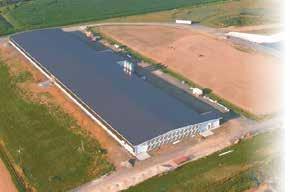


























Contact one of the following dealers to learn more:
IOWA
Prairie Land Ag Supply Inc. Rock Valley, IA 712-476-9290
United Dairy Systems, Inc. West Union, IA 563-422-5355
Monticello, IA 319-465-5931
WISCONSIN
Advanced Dairy Spring Valley, WI 715-772-3201
Bob’s Dairy Supply Dorchester, WI
715-654-5252
Ederer Dairy Supply Plain, WI
608-546-3713
DeLaval Dairy Service Kaukauna, WI 866-335-2825
Joe’s Refrigeration Inc. Withee, WI 715-229-2321
Mlsna Dairy Supply Inc. Cashton, WI 608-654-5106
Professional Dairy Services Arlington, WI 608-635-0268
Redeker Dairy Equipment Brandon, WI 920-346-5579
The Scharine Group Inc. Whitewater, WI 800 472-2880 Mt Horeb, WI 800-872-3470
MINNESOTA & SOUTH
DAKOTA
Farm Systems
Melrose, MN
320-256-3276 Brookings, SD 800-636-5581
Advanced Dairy Mora, MN
320-679-1029 Pierz, MN
320-468-2494
St. Charles, MN 507-932-4288 Wadena, MN 218-632-5416






























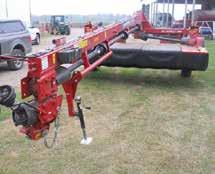





Claas 380 2015, Surface Wrap, 4 ft. bales, 5200
NH BR750 2005, Twine, 4 ft. bales, #564907 .............................................
JD 535 1990, Twine, 5 ft. bales, #578231....................................................
JD 535 1996, Twine & Surface Wrap, 5 ft. bales, #581566 ...........................
JD 560M 2019, Twine & Surface Wrap, 5 ft. bales, 5339 BC, #574784
JD 458 2011, Twine, 4 ft. bales, 200 BC, #576430 .....................................
JD 560M 2022, Surface Wrap, 5 ft. bales, 1516 BC, #547391 ...................
JD 560M 2019, Twine & Surface Wrap, 5 ft. bales, 6000 BC, #554127
JD 854 Silage Special 2013, Twine & Surface Wrap, 5 ft. bales, 7864 BC, #573441 ................................................................................
JD 568 2012, Twine & Surface Wrap, 5 ft. bales, 13519 BC, #576138
JD 535 1993, Twine, 5 ft. bales, #580570....................................................
JD 566 1999, Twine, 5 ft. bales, #578058....................................................







JD 630 2017, #570792
JD 936 2004, #581919
JD 530 2007, #578095
Kuhn FC883, #568119
JD 635 2011, #566470

JD 560M 2019, Surface Wrap, 5 ft. bales, 17500 BC, #575405 ..................
JD 460M 2021, Twine & Surface Wrap, 4 ft. bales, 1600 BC, #572264 .......
JD 450M 2021, Twine & Surface Wrap, 4 ft. bales, 2950 BC, #577084 .......
JD 560M 2020, Surface Wrap, 5 ft. bales, 3950 BC, #574425 ....................
JD 560M 2018, Twine & Surface Wrap, 4 ft. bales, 2550 BC, #574158 .......
JD 469SS 2013, Twine & Surface Wrap, 4 ft. bales, 5772 BC, #576404


JD 568 2010, Twine & Surface Wrap, 5 ft. bales, 14683 BC, #559585
JD 560M 2021, Surface Wrap, 5 ft. bales, 3400 BC, #575104 ....................
JD 560M 2023, Surface Wrap, 5 ft. bales, 7233 BC, #580417 ....................
Claas 380 2015, Surface Wrap, 4 ft. bales, 5650 BC, #568147
JD 460M 2023, Twine & Surface Wrap, 4 ft. bales, 1500 BC, #555076
JD 560M 2021, Twine &






Automated Waste Systems, LLC
Hull • 712-439-2081
Reiser Implement, Inc.
Waukon • 563-568-4526
Rexco Equipment Cedar Rapids • 319-393-2820
Rexco Equipment Farley • 563-744-3393
Bobcat of Brookings, Inc.
Brookings • 605-697-5544
Aldrich Tractor, Inc. Verdale • 218-445-5430
Farm-Rite Equipment, Inc. Dassel • 320-275-2737
Farm-Rite Equipment, Inc. Long Prairie • 320-732-3715
Farm-Rite Equipment, Inc. St. Cloud • 320-240-2085
Farm-Rite Equipment, Inc. Willmar • 320-235-3672
Lano Equipment of Norwood Norwood Young America 952-467-2181
Miller Sellner Slayton, LLC Slayton • 507-836-8571 Swanston Equipment Fergus Falls • 218-739-4505



Emmit (from le ), Colton, Amber, Charlo e, Garret and Hazel Duske sit together May 13 behind the milking barn on the Duske family’s farm near Waverly, Minnesota. The Duske family accomplished many tasks with the help of family members.



 By Mark Klaphake mark.k@dairystar.com
By Mark Klaphake mark.k@dairystar.com
WAVERLY, Minn. — Three generations of the Duske family worked together to face the challenge of a busy day of spring eldwork and farm chores May 13 near Waverly.
Garret Duske was joined by his dad, Cliff Duske, uncle, Keith Duske, and cousin, Nathaniel Farber, on the beautiful 75-degree day.
“Family, I can trust, and they know what I expect out of them,” Garret Duske said. “It’s fun to work with family. You are not guaranteed tomorrow, so you just enjoy the day with them.
Duske and his wife, Amber, have four children, Emmit, Hazel, Colton and Charlotte. The family milks 96 cows on the farm that was
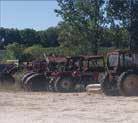

started by Duske’s grandfather, Herb, in the 1930s.
Cliff and Keith took ownership in 1970. Duske started taking over the farm from his dad and uncle in 2005.
The Duskes raise bull calves to 400 pounds and farm close to 500 acres.
“My passion is to be hands on with the animals and stuff on the farm,”

Garret Duske lls the mixer a er morning milking May 13 on the dairy he operates with his family near Waverly, Minnesota. Duske started his day milking at 4:30 a.m.






Con�nued from DAY IN THE
| Page 25 Duske said. “I like being there. We have been blessed in more ways than I can imagine with what we have.”
The day’s plan May 13 was orchestrated by Duske while doing the morning milking.
“Either the night before or during the morning milking, I am already planning out my day and what I should try to get done,” Duske said. “I usually nalize it when I am milking in the morning.”
Shortly after milking was complete, Duske mixed feed while Keith, Emmit and Farber arrived.
Keith cleaned the barn and then started his day in the eld, which included spraying preemergent herbicides on soybeans. Farber fed calves and then worked with Emmit to feed the total mixed ration to the cows.
Emmit, a freshman at Howard Lake-Waverly-Winsted High School, took the day off from school to plant corn and soybeans.
Emmit has taken on a greater role with eldwork since Cliff broke ve toes in a

Emmit Duske plants corn May 13 at the Duske family’s farm near Waverly, Minnesota. Duske took the day off from school to help his family with eldwork.

farm accident. Emmit cleaned up the 12-row planter and then lled the seed boxes with his dad.
When the father-son team added liquid fertilizer, they faced the rst adversity of the day. The hose broke on the
fertilizer tank, and fertilizer sprayed on Duske’s arms and legs.
“That was a sticky mess,” Duske said.
EMILY BRETH/DAIRY STAR
Colton Duske (le�) and his cousin, Nathaniel Farber, feed calves May 13 at the Duske family’s farm near Waverly, Minnesota. Duske and his siblings help their parents, Garret and Amber, on the family’s 96-cow dairy farm.




Once the hose was mended, they nished lling the planter. Emmit went to the eld to begin planting, and Duske went home to take a shower.
“I’d rather let everybody else drive the tractors while I stay on the farm because I know what has to be done there,” Duske said.
Turn to DAY IN THE LIFE | Page 27









EMILY BRETH/DAIRY STAR
Amber Duske prepares feed for the milking cows May 13 at her family’s farm near Waverly, Minnesota. Duske walked to the farm with her children to help with evening chores.

Farber, a college student at Southwest Minnesota State University, helps full time during the summer and part time during the school year. He helped nish calf chores before cleaning off and greasing the cultivator.
Cliff arrived around 10:30 a.m., and he and Farber sharpened the blades on the lawn mower before Cliff mowed lawn.
Once the tractors were humming in the eld, Duske and Farber grabbed their lunch, loaded the skid loader and

went to cut trees and move branches off the edges of a eld several miles from the farm. Duske said last year’s harvest was diminished because of the trees.
By 3 p.m., Duske and Farber were home, and they started working on evening chores.
Once Hazel, Colton and Charlotte got off the bus, they walked across a 10-acre eld to the farm with Amber to help with evening chores.
Farber fed cows and heifers and got ready to start milking.
Amber helped bring in fresh cows and helped Farber and Duske milk in the L-shaped barn. Duske has modied the barn with tunnel ventilation, new mats and larger stalls.
“That paid for itself in one year and makes us a lot of money every year,” Duske said. “I sell 20-30 heifers because I don’t need them.”
Charlotte helped care for chickens and calves, and Hazel helped milk and did chicken chores.
By 6 p.m., the busyness of the day was over.
Emmit nished planting 70 acres of corn and 20 acres of soybeans. Keith sprayed close to 120 acres of soybeans.
“It’s a regular, productive day,” Duske said. “From last Friday to Monday, we’ve had a lot of productive days. It was nice to keep moving without any major breakdowns.”
By late afternoon, plans switched to off-farm activities. Keith had a track meet to attend, Emmit went shing, and Duske, Amber, Hazel, Colton and Charlotte went home for supper.
“I try to get started earlier in the morning so people can have their afternoons,” Duske said. “It works pretty good.”
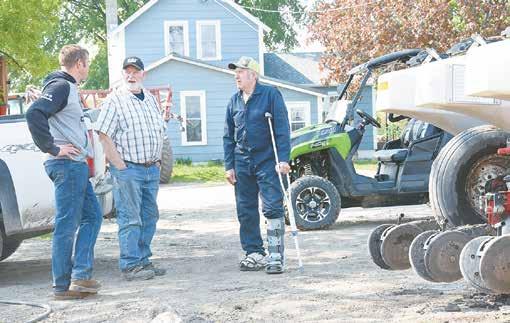

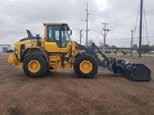














BARRON, Wis. — For most of her life, Summer Hammann has been developing the skills of observation, decision making and defending her rationale — all through her involvement in dairy judging.
That work paid off last month when Hammann, a senior at Barron High School, took top honors in the Wisconsin FFA Dairy Cattle Evaluation and Management Career Development Event in Madison.
Hammann lives on her family’s farm near Barron where they milk 40 registered Holsteins and Jerseys and raise beef cattle, sheep and turkeys.
“I started dairy judging in third grade in 4-H,” Hammann said. “I have actually been going to dairy judging practices with my older sister before that, and we would host dairy judging practices at our farm, so I was able to see what it was all about.”
Hammann has been involved with the Barron FFA Chapter, serving as chapter president in her junior and senior years. She competed in the dairy cattle evaluation CDE each year and has qualied for the state level every year.
Coming off her win at the state contest, Hammann is looking forward to next month’s state FFA convention, where she will receive the State FFA Degree and compete as a state nalist for both the star farmer award and the dairy entrepreneurship prociency.
Alongside her FFA involvement, Hammann is a three-season athlete, participating in volleyball, hockey, softball and track.
When she picks up her clipboard for dairy judging, Hammann said she most enjoys the process of evaluating each cow.
“I just like looking at the cows, breaking them down and evaluating them piece by piece, deciding why I place one over the other,” Hammann said.
Hammann said those early in their
dairy judging careers should take the time to learn and understand the parts of a cow, the function of each and what they should look like.
“Having a good understanding of the parts of the cow is really the foundation for the whole process,” Hammann said. “It will carry you all the way through, from placings and type analysis questions as a junior member to developing your reasons as you get older.”
While reasons have not always been her favorite part of the contest, Hammann said, with practice, she has gained condence in presenting them.
“Reasons take a lot of practice to get comfortable and condent,” Hammann said. “Don’t be discouraged if giving reasons is hard at rst or if you don’t do well in your rst contest. The more you practice, the easier it becomes, and you learn little tricks that will help you along the way.”
Learning to recall and visualize each cow in her mind has been the key to Hammann’s success with oral reasons.
“When I’m looking at the class, I make note of unique things about each cow that will help me picture her in mind later — the red cow, the black cow, the speckled cow or maybe one cow has a different kind of halter,” Hammann said.
Although she nished as the individual state champion, Hammann said her FFA judging career is ofcially over, as only the winning team advances to the national contest.
The end of her FFA judging career does not mean her judging days are over, however. Hammann will compete in the 4-H dairy judging contest this summer.
In the fall, Hammann will attend the University of Wisconsin-Madison. She will get nancial help by winning the Mercile J. Lee Scholarship, which provides a four-year, full-tuition scholarship and book stipend. The scholarship is based on service, scholarship and leadership. While majoring in dairy science and minoring in agricultural business, Hammann said she is hoping to procure a spot on the school’s dairy cattle judging team.
After completing her degree, Hammann said she is interested in working in the production side of the dairy industry, potentially working as a herdsperson on a dairy farm.
“I have always loved working with the cows,” Hammann said. “They are my passion. I can’t imagine a life without dairy cattle in it.”


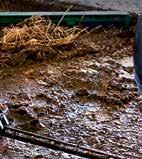





As we wheel into the spring season, we can say with condence that there will be plenty of time in the tractor to think — to dwell, reect, ponticate and muse about your farm, personal and professional relationships, and where the dairy industry is going.
There is a lot of security in making sure the tractor is ready to go. As we hop in and dive into planting like every time before, here are mental health tips to reect on.
proach strategy has been reported to decrease depression and hopelessness.
 By Dana Adams University of Minnesota
By Dana Adams University of Minnesota
Farming, especially in the rush of spring, can leave many in a state of tense reactions. This behavior of being primed to spring into action can also result in overwhelming anxiety, frustration, depression or fatigue, which ultimately leads to delayed planting.
These normal emotions become stronger when we don’t have time to anticipate the stressor, leaving us with negative emotions spinning around. When we face these stressors, we reexively reach for our coping skills, allowing us to process and return to feeling calm and in control.
There are two sets of coping styles: approach and avoidance.
Approach coping enables us to meet an issue head-on. Some examples of approach coping include acknowledging a stressor, looking for solutions, learning about a stressor and meditation. The ap-

Avoidance coping is a passive approach to dealing with a stressor. Examples of an avoidance strategy include denying there is a stressor, avoiding the problem, staying busy, venting or partaking in self-blame. Avoidance coping has been shown to increase acute stress, depression and hopelessness.
Naturally, working toward happier outcomes by choosing the best coping style is a skill that gets better with practice. Time in the tractor is an excellent opportunity to cycle through identifying stressors you are dealing with to explore solutions and practice meditation techniques, such as box breathing.
There will be time to think and practice all three throughout the growing season. Equally important is catching yourself when you slip back toward avoidance coping. Pause before an internal vent session or after you deny there’s a problem to a friend. Pause, reect and scroll through your internal notes on approach coping skills for an alternative so you can anticipate the next time your venting takes center stage.
These behaviors and cycles are easily lost or too overwhelming to the person experiencing them but may be observed by other important people in


Payloader, 5 hrs ....................................$87,900
UW-56 Toolcat, Cab, Hi Flow Aux, 202 hrs ..$64,500
T-870, Glass Cab with A/C, 2 Spd, 1475 hrs $69,500 ‘19 T-770, Glass Cab with A/C, 2 Spd, 870 hrs ..$65,000
‘17 T-650, Glass Cab with A/C, 2 Spd, 2700 hrs $49,500
‘19 S-770, Glass Cab with A/C, 2 Spd, 3350 hrs $38,900 (2) ‘21 S-76, 2650 hrs and up ............Starting at $42,500
‘12 S-650, Glass Cab with A/C, 2 Spd, 2500 hrs $46,500
‘18 S-595, Glass Cab with A/C, 2 Spd, 3850 hrs $29,900 ‘02 S-185, Glass Cab with A/C, 2 Spd, 3650 hrs $24,900 ‘01 773, Glass Cab with A/C, 7000 hrs ...............$16,500 ‘97 763, Glass Cab & Heater ..............................$12,000 ‘21 Cat 259D3, Glass Cab with A/C, 2100 hrs ....$59,900 ‘20 Kubota SVL75-2, Glass Cab w/A/C, 345 hrs $59,900 USED TILLAGE
‘04 W-R Quad X, 46’, 4 Bar Spring Tooth Harrow$19,300 ‘04 W-R Excel 38’, 4 Bar Spring Tooth Harrow ...$12,900 WR 2500, 28’, 4 Bar Spring Tooth Harrow ...........$6,950 Case IH 4300, 25’ .................................................$7,500 Glencoe 26’, 3 Bar Spring Tooth Harrow ..............$1,800
‘00 N-H 1441 Disbine, 15’ Cut ............................$11,900
‘11 N-H H-7450 Discbine, 13’ Cut .......................$20,900
‘15 N-H H-7230 Discbine, 10’ Cut .......................$19,900 (2) ‘03 N-H 1411 Discbine, 10’ Cut ......Starting at $9,900
‘08 N-H 616 Discmower ........................................$5,500 AGCO 1326 Discmower........................................$3,250
‘20 N-H 560 Rd Baler, Specialty Crop, 4000 Bales$46,500
‘11 N-H BR-7090 Rd Baler, Cornstalk Special, Netwrap.............................................................$23,900
‘06 N-H BR-740A, Twine only ...............................$9,500
NH 688 Rd Baler ...................................................$5,900
JD 336 Baler .........................................................$2,950
‘22 N-H 3223 Rake .............................................$31,900
‘22 H&S AR-2112 Rake ........................................$8,500
‘05 H&S BC12HC, 12 Wheel Hi Cap Rake ...........$8,950 ‘20 H&S 5200H Tedder, 4 Basket unit ..................$6,700 USED MISC
‘10 W-R 20’ Stalk Chopper, Nice Shape .............$10,900
‘07 Feterl 10x72 Auger, w/ Swing drive hopper .... $5,950
‘05 Feterl 8x60 Auger, Galivnized .....................$1,750
‘16 H&S S3131 Spreader ..................................$7,950 Gehl 325 Spreader ............................................$4,950 (2) JBM 7X20 Feeder Wagons................Each $4,000
‘13 W-R 513 Soil Pro, 7 Shank, Harrow..............$29,500 WR 957, 9 Shank, Harrow ..................................$12,900 JD 2700, 7 Shank ...............................................$14,500 DMI Tiger III, 3 Shank Ripper ...............................$3,300 Pepin Spike Harrow, 5 Section .............................$2,500 USED PLANTERS White 6700, 12x30, Verticle Fold ..........................$7,500 USED HAY EQUIPMENT



their lives. Partners, parents, co-workers or clergy members may notice and offer support. There are several steps that members of a support system can offer to bolster their loved one.
Showing that you care is an oftenunderappreciated step in helping someone you care about. The effort to show that a person is cared for will differ from person to person but is valuable. Actions like being present, listening and offering supportive touch are often helpful practices. Also, remember to practice active listening, saying things like, “This seems really hard. Thanks for sharing with me.” These comments are not disingenuous. You’re being transparent, reminding them they are valued.
Another practice that members of a support system can use is to notice behavior changes. These changes may be markers of more serious mental health concerns. One-off behavior changes are not excessively concerning.
Behaviors that are concerning are changes to routines, leisure activities or sleep patterns. These changes can also show up as an increase in the quantity or frequency of alcohol use, sleeping later than usual or not sleeping at all, and not engaging in activities that used to be enjoyable. Members of a person’s support system don’t need to know everything,
Dana Adams adam1744@umn.edu 320-204-2968
Joe Armstrong armst225@umn.edu 612.624.3610
Luciano Caixeta lcaixeta@umn.edu 612-625-3130
Gerard Cramer gcramer@umn.edu 612-625-8184
Marcia Endres miendres@umn.edu 612-624-5391
Les Hansen hanse009@umn.edu 612-624-2277
Brad Heins hein0106@umn.edu 320-589-1711
Nathan Hulinsky huli0013@umn.edu 320-203-6104
Karen Johnson ande9495@umn.edu 320-484-4334
Emily Krekelberg krek0033@umn.edu 507-280-2863
but noticing that practices and behaviors have changed and offering more support is what is important when considering next steps.
Finally, ask, in an appropriate time and place, how someone is really doing and what you can do to help. Typically, this is best done in a one-on-one conversation, allowing individuals to open up about whatever they are experiencing. Individuals may need a listening ear, a hug or someone to brainstorm solutions with. Ask and respond in a way that will provide what they need in that moment.
If a person’s distress doesn’t seem to lessen after talking openly, the next essential step is to ask if they are considering hurting themselves or someone else. Although this may be uncomfortable, asking about suicide does not increase the likelihood that someone will attempt to end their life and may reduce their distress and thoughts of suicide. If a loved one says they are considering ending their life, stay with them and help them get the appropriate support they need.
Your time in the tractor has a multitude of benets. While getting crops in the ground, you also have time to reect on what brings you happiness and what thoughts and behaviors should be addressed. You can access tools to bring you toward a calm future.
Claire LaCanne lacanne@umn.edu 507-332-6109
Brenda Miller nels4220@umn.edu 320-732-4435
Isaac Salfer ijsalfer@umn.edu 320-296-1357
Jim Salfer salfe001@umn.edu 320-203-6093
Mike Schutz mschutz@umn.edu 612-624-1205
Melissa Wilson mlw@umn.edu 612-625-4276
Isaac Haagen hagge041@umn.edu 612-624-7455
Michael Boland boland@umn.edu 612-625-3013
Sabrina Florentino slpore@umn.edu 507-441-1765











MADISON, Wis. — In an annual contest emphasizing critical on-farm thinking, the team from the University of Wisconsin-Madison came out on top this year.
The team of four dairy science students took rst place at the North American Intercollegiate Dairy Challenge April 4-6 in Visalia, California.
Nicole Broege of Janesville, Anastasia McCourt of Fond du Lac, Melissa Konkel of Sharon and Luke McCullough of Monroe were coached by Eric Ronk, with support from current and retired faculty and staff in the department of animal and dairy sciences.
“The competition level is extremely high as these students are the best of the best coming from across the U.S. and Canada to compete,” Ronk said. “There are a lot of strong dairy programs and universities represented, and the bar continues to be raised in this contest.”
Dairy Challenge is an applied dairy management competition. Students analyze a farm and present their observations and management recommendations to a panel. Judges include dairy producers, veterinarians, farm nance specialists and agribusiness personnel.
The contest consists of four divisions with eight teams per division. Groups A and B went to River Ranch Dairy in Hanford, California, and groups C and D went to Flint Dairy in Hanford, California.



of Wisconsin-Madison students Nicole Broege (front, from le ), Anastasia McCourt and Melissa Konkel; (back, from le ) Luke McCullough, Brianna Wanek, Eric Ronk, coach, and Zachary Olson hold up their awards from the North American Intercollegiate Dairy Challenge April 4-6 in Visalia, California. Broege, McCourt, Konkel and McCullough were on the UW-Madison team that took rst place in the contest, while Wanek and Olson won awards compe ng on aggregate teams with teammates from other universi es.
The UW-Madison team analyzed River Ranch Dairy, which milks 5,600 cows, raises 5,000 youngstock and employs more than 68 people. The UWMadison students had the highest team score not only on the farm they analyzed but in the entire competition.
“Western dairy farming takes on a whole different look, and it was an incredibly exciting and fun challenge to


take what we have learned from our experiences in the Midwest and apply similar concepts in the West,” Konkel said.
Ronk said the team focused its opportunities on feed pile management, feed particle size and calf management. Ronk said the focus on feeding management was key in the judges’ opinion.
“One judge also mentioned our nancial impacts were more realistic on


the numbers side, as not every opportunity a team suggests will hit the top dollar or milk production increase amount,” he said.
Over 128 students from 32 teams completed the on-farm analysis, with two hours to visit and observe the farm’s operation.
McCullough said their team’s approach was to split up for a majority of the farm visit, planning and mapping out their visit the night before.
“There was a lot of time spent walking since the farm site was spread across over 250 acres,” McCullough said. “We regrouped at the end of the visit to share our ndings and make sure all parts of the farm were looked at and notes taken.”
When examining areas of improvement, Broege said recommendations must make sense nancially and practically. Teams receive the farm’s data and records the night before visiting the farm, which Broege said allowed them to identify areas they wanted to look at.
After a question-and-answer session with the farm owners and advisers, the student teams developed recommendations for nutrition, reproduction, milking procedures, animal health, cow comfort, and labor and nancial management.
A great deal of preparation goes into getting ready for the event.
“This competition encompasses all four years of curriculum and dairy experience for students,” Ronk said. “Our dairy herd management courses and senior capstone class play a critical role in preparing the students.”
























How did you get into farming? My grandpa bought the farm and started with beef and hogs. Then, my dad took over the farm, and we built the dairy barn in 1984 when I graduated.
What are the most signicant ways your farm has changed since you started farming? We put up more sheds and improved the heifer and dry cow facility. Also, we’ve kept up with advancements with equipment.
What was a challenge you faced in your dairy farming career, and how did you overcome it? Putting up with residential sprawl and trying to nd another piece of land. I just keep chugging along so I can keep farming. I have been losing land to housing. We were farming 850 acres, and now, we are down to 550 acres.
What is the best decision you have made on your farm? We stopped raising a lot of chickens. Now, we just have a small ock of around 200. We also started raising beef. Being diversied and having a little bit of everything has helped us keep going.
What three things on the farm can you not live without? My kids, for sure, because they have always been with me, helping me. We always gured out how to get it done. The skid loader for getting the animals taken care of. The big square baler so we don’t have to deal with all of the small squares.
What are your thoughts and concerns about the dairy industry for the next year? If the milk price
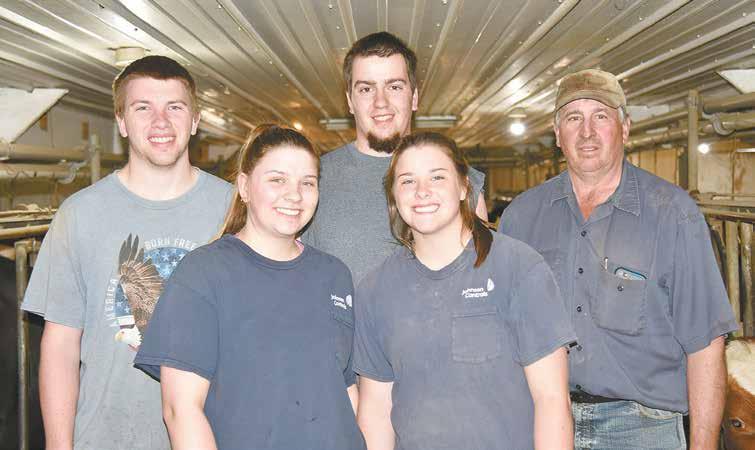
doesn’t get better, there is going to be a lot more farmers quitting and leaving. It’s sad for the younger ones because they don’t get the opportunity to farm because they need to work off farm to be able to support a family. I’m grateful I could support a family with my wife who worked out.
What strategies do you use to withstand the volatile milk prices? We are raising beef cattle to get an added income. We ne-tuned the cost of things and cut back on input cost in ways that didn’t hurt the milk production. We are breeding with a bull rather than using A.I. to save time and make sure they are getting bred back.
How do you maintain family relationships while also working together? We make a lot of jokes and try to make it fun in the barn. The girls poke fun at me. We have fun and communicate with each other if there is something that bothers each other. If I
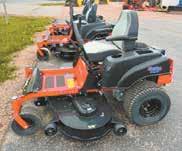













have a habit they don’t like, they let me know and mock me, which helps keep it light. We also rotate who is at the farm so they all get a day off.
What do you nd most rewarding about dairy farming? I enjoy that all my kids are here and come around for dinner and farm. I can see how growing up on the farm has impacted them, because of their school and work capabilities. I’m very proud of my kids. The farm faced many challenges for us all, and it shows in the way the kids are.
Tell us something special about your farm. It’s special for the kids that their grandparents live on the farm and they can talk to them every day. Also, the whole family is close, including my brothers and sisters, and we get together. The community around us is
special. Everyone is kind and willing to help.
What are your plans for your dairy in the next year and ve years? For the next year, it’s just to keep going with the farm the way it is. In ve years, when the kids get careers off the farm, the dairy will have to go because I won’t be able to do it on my own.
How do you or your family like to spend time when you are not doing chores? We do a lot of games and random things outside; we are a fairly competitive family. We play the Wii when it’s not nice outside, and we always laugh with each other. We always get dinner for birthdays, and we have dinner once a week with all the kids, even the ones who moved off the farm.
At UW-Madison, students enroll in a one-credit course during the spring semester to prepare for Dairy Challenge. Featuring guest speakers each week, the course includes a mock farm audit complete with a panel. Prior to attending the national event, Ronk said most students have competed in a regional event and/ or attended the National Dairy Challenge and Academy.
When it comes to implementing suggestions made by the students, Ronk said the hope is that the farms talk over the recommendations with their management team.
“They clearly need to make their own decisions as we are only visiting for a snapshot in time and do not have the full background on everything,” he said.
Broege, who graduated in May, said working with her teammates is what she enjoyed most about the experience.
“We’ve taken years of dairy-related courses together, and it was incredibly rewarding to end my college career with them, utilizing our education and working together,” she said. “Participating in Dairy Challenge helped me understand more fully that no matter what sector of the dairy industry I have a career in, every part of the farm affects the entirety of the operation, as well as that farm’s future.”
McCullough, who also graduated in May, will be attending UW-Madison’s School of Veterinary Medicine to become a large animal veterinarian.
“My participation in Dairy Challenge will benet me as a veterinarian because I will be able to walk onto a dairy farm and view the farm by the full picture to potentially identify issues affecting animal health,” McCullough said. “The contest also builds teamwork skills and allows participants to use much of the knowledge learned in the classroom in a practical setting.”
Konkel, also a recent graduate, said that even though Dairy Challenge may not directly correlate to her job as an ag-
riculture educator, the contest has shaped the way she thinks and looks at a challenge.
“The ability to critically analyze a given farm or situation and realize what would work best both practically and nancially for that farm is a type of critical thinking that can be applied in any eld of work,” she said.
Two other UW-Madison students also won awards competing on aggregate teams with teammates from other universities. Brianna Wanek of Cashton was on a winning aggregate team at River Ranch Dairy with students from Delaware Valley University, Pennsylvania State University and the University of New Hampshire.
Zachary Olson of Sturgeon Bay was on a second-place aggregate team at Flint Dairy with students from Alfred State College, Cornell University and the University of New Hampshire.
“Participating in Dairy Challenge provides countless benets,” said Olson, who grew up on his family’s 60-cow robotic dairy farm. “You build condence by going on a new dairy farm and assessing weaknesses and strengths while also nding realistic solutions to help improve the dairy. The network that Dairy Challenge exposes you to in the industry is also invaluable.”
Olson will be starting his career as a dairy nutritionist and said these skills will help him to help farmers.
Through Ronk’s work with the students, he said he sees the value gained by those who participate in Dairy Challenge.
“Any student involved in Dairy Challenge can learn lifelong skills, like teamwork, decision making, partial budgeting, presentation and communication skills, networking and more,” Ronk said. “Students who work in the dairy industry gain so much valuable experience throughout the whole process. It is truly a world-class event.”






















965-1000


Talk about progress. Our farmers never cease to amaze me. When the conditions are right, signicant progress can be made to get the crops in the ground. It is simply amazing how much corn and soybeans were put in once the conditions improved.
As livestock producers, are you taking advantage of all the opportunities available to you? Have you reported your pasture acres to the Farm Service Agency the past few years? If you have and your county was an eligible disaster county for the Livestock Forage Disaster Program, you are well aware of the benets to ensuring you have certied your pastures by the July 15 deadline. Many counties triggered for LFP payments in 2021 and 2023. The weather for 2024 has not been dictated as of yet. As soon as you are done planting, call the FSA ofce to schedule an appointment.
Many producers have the opportunity to accomplish this task before the rst cutting of hay goes down. Take the opportunity to act upon this if you can. Call the FSA ofce to schedule that appointment.
Maps are available at the FSA ofces for acreage reporting purposes. If you wish to receive maps by email, call the ofce or email.
The deadline for spring-seed crops in Minnesota counties is July 15.
In order to maintain program eligibility and benets, you must le timely acreage reports. Failure to le an acreage report by the crop acreage reporting deadline may cause ineligibility for program benets. FSA will not accept acreage reports provided more than a year after the acreage reporting deadline.
All producers are encouraged to contact the FSA ofce for more information on the nal planting date for specic crops. The nal planting dates vary by crop, planting period and county, so contact the FSA ofce for a list of county-specic planting deadlines. The timely planting of a crop, by the nal planting date, may prevent loss of program benets.
The deadline for corn for grain is May 31, and the deadline for soybeans for grain is June 10.
When certifying organic acres, the buffer zone acreage must be included in the organic acreage. You must also provide a current organic plan and an organic certicate or documentation from a certifying agent indicating an organic plan is in effect. Documentation must include name of certied individuals; address; telephone number; effective date of certication; certicate number; list of commodities certied; name and address of certifying agent; and a map showing the specic location of each eld of certied organic land, including the buffer zone acreage.
Certication exemptions are available for producers whose annual gross agricultural income from organic sales totals $5,000 or less. Although exempt growers are not required to provide a written certicate, they are required to provide a map showing the specic location of each eld of certied organic, transitional and buffer zone acreage.
For questions about reporting organic crops, contact your county’s U.S. Department of Agriculture Service Center.
Stay safe this spring, and make safety your No. 1 priority.
Farm Service Agency is an equal opportunity lender. Complaints about discrimination should be sent to: Secretary of Agriculture, Washington, D.C., 20250. Visit www.fsa.usda.gov for application forms and updates on USDA programs






I can quickly make a list of things that irritate me, like that piece of straw that is stuck in my sock. I sit down, take off the sock and look through it, searching to nd that poking piece that has lodged itself into a spot where I cannot see it. I put it back on, only to feel it again. After several minutes of failing to nd it, I am ready to throw it away.
The same thing happens when I get a thorn in my glove. I know it is there like a sliver. I run my nger back over it, with the notion I will nd it sooner or later. All the while, I have stopped working and am losing my patience. These little things that scratch my skin and poke my ngers irritate me.
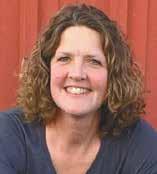 By Tina Hinchley Farmer & Columnist
By Tina Hinchley Farmer & Columnist
In the barn, the fans are blowing hard all day and night. We have one with a squeaky fan belt. It is hardly noticeable, until I am in that area near the wind it is creating to keep the cows cool. I sometimes get a dull headache. I surmise it is from that whining I hear but don’t put my nger on it until I leave the barn. The fan is doing its job. I will request someone to x it, but it is planting time. Cutting hay is just days away. I don’t think it will get taken care of any time soon. The sound of the fan’s belt annoys me, but I walk out of the barn and forget about it until I return.
The windchime on our porch sounds beautiful when there is a breeze. It is a tuned chime that was purchased after my mother passed away. She had many in her yard. This musical chime can tell us how windy it is and when I need to put on a sweatshirt before heading out in the morning. There are times, though, when I am on the phone or having a quiet moment on the couch that it is simply too much. I get irked by the noise pollution and want it to be silenced. That can easily be done by taking it down. Piece of cake; no big deal.
Just recently, on my drive to Madison, it was raining, and I was behind a vehicle that was driving cautiously. She had her wipers going full force, and she was going about 45 mph. I stayed back and had ample room in case she needed to turn or slow down further. As the miles went by, there was a line of trafc behind us. The divided highway was coming up, and I made plans to pass. As I signaled to pull into the left lane, the car behind me did the same. He was experiencing frustration, as he beeped his horn for a long while, startling me back behind the slow driver. I looked over, and he was using the middle nger up hand gesture while swearing at me with his horn whaling. Clearly, he was having an emotional meltdown and feeling the need to show it.
The passengers that were in the car with me were thinking I pulled out in front of him as if it was close enough that I was going to be in an accident. However, my mirror signal that warns about cars surrounding didn’t light up. I shook my head and thought about the anger and rage that man had because he was behind two cars for a few miles going 45 mph.
Not two days later, my daughter, Anna, came ying into the house upset. She had come from the bank, and there was a turtle on the road. She pulled over with hazard lights on, and the car behind her swerved wide and hit the turtle, causing it to ip over into the oncoming lane. There was a car in the distance approaching while Anna was in the middle of the road picking up the turtle. The oncoming driver could clearly see she was in the road picking up something, but he refused to slow down and beeped his horn at her while going 55 mph and swerved into the gravel ditch as Anna was crossing back over the yellow line with the turtle.
Anna was shaking being that close to a fast car. The other driver that hit the turtle couldn’t believe the oncoming driver had such disrespect and did not slow down when someone was on the road. Anna was a short distance from the line and could have easily been hit. The turtle was saved and put in the ditch where it was attempting to cross.
May is Mental Health Awareness Month. This month is observed to raise awareness about depres-
sion and anxiety, and other forms of stress and mental illness. Road rage is dened as driving a vehicle in an aggressive manner that could endanger the safety or property of another driver, motorcyclist, bicyclist or pedestrian in an effort to intimidate or release frustration. Strategies include but not are limited to cutting motorists off, inappropriate honking, using obscene gestures, swearing, tailgating, brake checking and attempting to create fear with aggressive motives.
While I may get irritated and annoyed with drivers on the road, I am recognizing more drivers who
are unable to control their anger. I ask all drivers to drive defensively and watch for all types of dangers while traveling. Drive safe and give yourself enough time to get where you need to go without putting stress on yourself or others. Everyone needs to respect others, even, and especially, if there is a person on the road picking up a turtle.
Tina Hinchley, her husband Duane and daughter Anna milk 240 registered Holsteins with robots. They also farm 2,300 acres near Cambridge, Wisconsin. The Hinchleys have been hosting farm tours for over 25 years.









In a perfect world,
My house would be clean
My dishes all done
The oor would gleam
In a perfect world
There would only be owers
Yet, I don’t mind weed pulling
Just need more hours
In a perfect world
When it chooses to rain
Would be the ideal times
Then no one could complain
In a perfect world
Children wouldn’t ght
They would talk nice to one another
From morning until night
In a perfect world
My energy wouldn’t wane
The more I had to do I would only gain and gain
In a perfect world
Sick cows wouldn’t go down
They would sort themselves out
Find their own ride to town
In a perfect world
The mosquitoes would kiss
Instead of the stings, It would be bug bliss
In a perfect world
You could reason with pigs “I will let you run and play
Provided no one digs!”
In a perfect world
My sheep wouldn’t sneak out
Touring the farm weekly
Simply to see what’s about
In a perfect world
Cancer is cured with a hug
Not one of hesitation
But one nice and snug
In a perfect world
The words that need said
Would oat above our heads
Like cartoon characters and be read
This world is far from perfect
Amazing, incredible, and great



 By Jacqui Davison Columnist
By Jacqui Davison Columnist
Try living each day to the fullest
It’s an adventure; why wait?








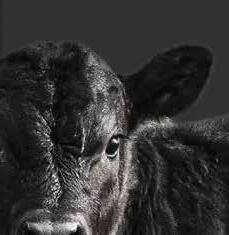


Jacqui Davison and her family milk 800 cows and farm 1,200 acres in northeastern Vernon County, Wisconsin. Her children, Ira, Dane, Henry and Cora, help on the farm while her husband, Keith, works on a grain farm. If she’s not in the barn, she’s probably in the kitchen, trailing after little ones or sharing her passion of reading with someone. Her life is best described as organized chaos, and if it wasn’t, she’d be bored.


























A mild winter, periods of warm, dry weather and early south winds have led to reports of high bug pressure in alfalfa elds.
Many types of insects are found on alfalfa. The benecial insects include pollinators, parasites and predators. Other insects, which feed on the leaves, stems, crowns, seed pods and owers, can cause economic loss when they become abundant.
 By Barry Visser Nutritionist
By Barry Visser Nutritionist
Alfalfa weevil
The alfalfa weevil is an early-season alfalfa pest in the Midwest. They are most damaging in the larvae stage as they can skeletonize leaves so only leaf veins or holes remain. This causes stunted plant growth and reduced forage yield and quality. Larvae are yellow to green with black heads and a white stripe along the back.
Young larvae feed on the leaf buds and between folded leaets in the plant terminal. Older larvae feed mostly on open leaets, but they also feed on the terminal buds. From a distance, the foliage damage appears grayish to white. Mature larvae then drop to the leaf litter and spin silken cocoons. The adult weevils emerge from the cocoons in one to two weeks. The new adults emerging in late spring feed for a short period and then leave the alfalfa eld to go to nearby protected areas for a summer resting period, returning to the elds again in the fall. Adults also feed on the leaves but cause less damage.
The rst cutting is at the greatest risk for alfalfa
weevil damage. However, in some years, larvae and adults may threaten subsequent cuttings and require treatment.
The potato leafhopper is perhaps the most serious alfalfa insect pest in the Upper Midwest. Although it’s a native species, PLH cannot survive northern winters, so adults migrate into the Midwest each spring. PLH can be confused with other small, soft-bodied insects such as aphids, but PLH have elongated bodies and tend to be mobile compared to aphids.
Leafhopper populations frequently increase to damaging levels on the second and subsequent alfalfa crops. They can be especially damaging on new alfalfa seedings, particularly near weedy areas where they can have larger populations. Once PLH colonize in alfalfa elds, adults deposit eggs into stems and leaf veins. In warm weather, these eggs develop into adults in about three weeks, so populations can increase quickly.
Leafhoppers have piercing-sucking mouthparts and extract plant juices. Heavy feeding disrupts nutrient ow within plants, causing V-shaped yellow triangles to form at the leaet tips (“hopper burn”), but this evidence of damage does not develop until seven to 10 days after feeding begins. As feeding continues, damage gets worse, and the chlorotic areas spread toward the base of the leaet. Once hopper burn is evident, economic loss has occurred.
Historically, crop scouting and insecticide application when warranted was the only effective means of PLH management. However, glandularhaired alfalfa varieties are having an impact on how we manage this pest.
Aphids
Aphids are soft-bodied, slow-moving insects that live in colonies and suck plant sap from stems, leaves and terminals. Three primary species of

aphids feed on alfalfa in the Midwest: pea aphid, cowpea aphid and spotted alfalfa aphid. Infested plants turn yellow and wilt, and their growth can be stunted. Honeydew can accumulate on the leaves and stems with certain species. Predatory insects and parasites, aphid diseases and weather conditions often keep aphid numbers low. However, aphids have a high reproductive rate and can increase rapidly under favorable conditions.
The most common aphid species is the pea aphid. Adults are bright green with long legs. They are about one-eighth inch long, making them the largest aphid species found on alfalfa. Only the tip of each antennal segment is black, differentiating it from other aphid species. Pea aphids congregate in dense colonies along the stems, terminal shoots and leaves. Damage is often most prevalent in the spring because pea aphids like cooler temperatures.
Scouting
Each week during the growing season, check for insect activity in at least four or ve spots in each eld. Pest populations can vary across elds, and results may be inaccurate if you check only a limited area. Sample away from the eld edges, and avoid sampling when the elds are wet from rain or dew, which makes it difcult to detect insects.
Once physical signs of damage are present in an alfalfa eld, you may already be behind in terms of treatment. Early cutting can be a management strategy depending on bug severity relative to alfalfa growth. Some bugs nd it difcult to survive once vegetative foliage is removed, especially under sunny conditions.
Work closely with your agronomy team to develop an effective scouting plan. Your cows and pocketbook will appreciate the improved alfalfa quality and yield.
Barry Visser is a nutritionist for Vita Plus.







1850 CH hrs., #582099 ....... $219,000
JD 9600 2022, Kernel Processor, PRWD, 663 hrs., 507 CH hrs., #576032 ........... $499,900






JD 9600 2021, Kernel Processor, PRWD, 892 hrs., 538 CH hrs., #565399 ........... $420,000 JD 9600 2020, Kernel Processor, PRWD, 1310 hrs., 775 CH hrs., #565393 ......... $375,000 JD 9600 2019, Kernel Processor, PRWD, 1311 hrs., 811 CH hrs., #532049 ......... $369,900
JD 9600 2019, Kernel Processor, PRWD, 1743 hrs., 1130 CH hrs., #553763 ....... $329,900
JD 9700 2021, Kernel Processor, PRWD, 832 hrs., 527 CH hrs., #571817
JD 9700 2021, Kernel Processor, PRWD, 1205 hrs., 900 CH hrs., #579477
JD 9700 2020, Kernel Processor, PRWD, 969 hrs., 500 CH hrs., #552460 ...........





What’s the difference between adapt and adopt?
Both are action verbs with the change of one little vowel creating a special moment. Think of this: Adapting old ideas by adopting new technology. One is an aaah moment, the comfort of familiarity of the past. The other generates an oooh moment of excitement for what is to come. We’ve had a few of those moments around the farm these past few weeks.
We are all learning lessons while we try to hang on to the comfort of, “It’s just how things are done,” coupled with the realization that there might be a better way. This is the rst time in 50 years that Mark has not led the charge in starting the growing season. He was just 14 years old when his dad announced he couldn’t plant the corn crop that year. Mark hooked the tractor up to the planter and headed off to the backelds to adapt to his new job.
He has adapted from a 4-row plate planter to a 6-row narrow planter. He would eventually adopt a liquid fertilization system as his body refused to lift several tons of fertilizer by a bushel basket from the wagon to dump it into the fertilizer boxes on the planter. It was amazing how quickly he could get the job done by adopting one change — an oooh moment.
This year, Austin and Mark are adapting to their situation in life and adopting ideas along the way. Austin is generating oooh moments as he has installed a GPS system on the tractors and modied the planter to plant green. He has studied, read and talked with so many people using old ideas with new technology. It rubs on Mark’s vision of how to grow crops, but kudos to him for giving Austin some backelds to adapt his theories to work on our land
The equipment updates and planting strategies

appear to be working. The cornelds by the road are marked with green dotted parallel lines running north and south. The rows are even straighter than Mark’s, and those very rarely had a weave in them. The elds closest to the road are always your straightest. Austin tried growing a green eld of corn by direct seeding into an alfalfa eld and then spraying to kill the alfalfa growth. This is one of our sandiest elds, and he is hoping to generate more crop protection while reducing watering needs. He is trying to adapt his planting strategies to the land available to him.
It seems this next generation is adapting old ideas while adopting new technologies to create a successful result. The reduced, no-till craze in the 1970s was a novel idea that didn’t have the technology to support its success. Fast forward, and the old idea is new again. The technology has caught up to the ideas, kind of like bell bottom jeans. I wonder what will be the next old idea to become new again?
 By Natalie Schmitt Columnist
By Natalie Schmitt Columnist
Once a new technology is adopted, it seems difcult to imagine what life was like without it. Mark was resistant to have a cell phone. He watched and grumbled as the kids ddled, texted and chatted on their phone what seemed like non-stop. Once they were all on their own, he decided he needed to get one too.
At the same time, Austin lost his expensive phone down an ice shing hole with no chance of recovery. Together, they went to nd new phones which could withstand chores, dirt and a myriad of other situations on the farm that could shorten the life of any phone. They ended up picking out a couple of cheap phones from Walmart for $18 each. If it broke or was crushed by a piece of equipment, it wouldn’t be a big loss. Since it was such a good deal, they grabbed a couple of extra phones as a type of warranty plan.
It has been a good strategy. After several years, the camera on Mark’s original phone didn’t work anymore, so he shifted over to his backup phone. It didn’t last as long as the rst one. The charging port was damaged, and his battery was losing life quickly. He needed to save all his pictures and contacts before they were all lost in space. For four days, he was without his phone. It was like going back to the Dark Ages. He couldn’t call anyone whenever he wanted to. He couldn’t see the milk or crop reports at his ngertips. He couldn’t laugh at shared Snapchats with the kids. He didn’t realize how dependent he had become on his phone. Eventually, he was able to convert Austin’s extra phone over to his number, and he has been reconnected with his world.
I had a similar technical loss. My PC has been going since 2009. It has become the B John Deere of the ofce. It still runs, but it just can’t do the work. I’ve been without my computer for a week as they update, revive and restore all my les. I didn’t realize how I write by typing. It has been interesting working on this article. Mark isn’t the only one who has embraced technology and can’t imagine how we ever survived without it.
As their four children pursue dairy careers off the family farm, Natalie and Mark Schmitt started an adventure of milking registered Holsteins just because they like good cows on their farm north of Rice, Minnesota.




Sunshine. Lilac blossoms. Occasional showers. Emerging corn. Fluffy baby chicks. A ood of new calves. May is full of joys, both big and small.

 By Sadie Frericks Columnist
By Sadie Frericks Columnist
We had two sets of healthy twin heifer calves born during the rst week of May. Since we now rely mostly on blood testing to detect pregnancies, twins are always a surprise. Lincoln’s twins arrived during the night, and she had them all uffed up by the time we rst checked the calving pen that morning. Smoke calved in the early evening, so her twins were slow-motion surprise.
Smoke was vigorously cleaning her calf off when Monika asked, “Is that a foot?” Sure enough, another foot was toeing into the world. A few minutes later, Smoke had another baby to clean. The look on Smoke’s face made me think that cows are just as surprised as we are when two arrive instead of the customary one.
Lincoln’s twins were born the morning of Dan’s junior prom, so one of the calves made an appearance in the photos he took with his date. It was Monika and Daphne’s idea, so they carried the calf to the yard for the photo shoot. The calf cooperated perfectly, and we got adorable photos.
The grass seems greener than green this spring, likely because it’s such a contrast to the drab hues of last summer’s drought. The cows went out to pasture earlier than ever before. They must remember the dismal grazing of last summer, too, because even they seemed extra exuberant about their return to the paddocks.
The funniest part of “cows out”
day was watching our older cows. In years past, we’ve corralled the cows in the yard, opened the gate, and then ushered them to pasture. This year, we let them trickle out.
It was early afternoon before we nished double-checking the fences and opened the gate. The old ladies were napping in the sand barn when we started letting the younger cows out of the tiestall. During the winter, when we switch, the tiestall cows only have access to the southern half of our cowyard. When we let them out that day, they had access to both halves of the cowyard and the sand barn.
Several young cows thought they were getting away with being where they shouldn’t and began frolicking like cows do when they’re out. They didn’t even notice the open pasture gate and, instead, pranced up to the sand barn. A couple old ladies emerged from their stalls with looks on their faces that said they were thinking, “What in the heck are you young girls doing in here?”
Awakened from their siestas, these older cows moseyed down to the cowyard. For these seasoned grazers, it only took a few moments to notice the open pasture gate. December, who is starting her ninth grazing season, wasted no time marching through the gate and out to pasture. Jessi, in her eighth season, tailed close behind. Not long after, the younger cows caught on and followed their lead. For the next half hour or so, every couple minutes, a few cows would wake up, catch on that something was out of the ordinary, poke their heads out of the sand barn, see the other cows already in the pasture and sprint down to the gate and out through the lane. Once their hooves hit grass, their heels kicked for the sky like they were young heifers again. If there was ever any doubt that cows feel joy, the rst day of grazing is proof that they do.
I hope your May is lled with joys as well.
Sadie Frericks and her husband, Glen, milk 100 cows near Melrose, Minnesota. They have three children: Dan, Monika, and Daphne. Sadie also writes a blog at www.dairygoodlife.com. She can be reached at sadiefrericks@ gmail.com.
























